- Entertainment
- Breaking Down the Complicated Time Travel in <i>Avengers: Endgame</i>

Breaking Down the Complicated Time Travel in Avengers: Endgame
Warning: This post contains spoilers for Avengers: Endgame .
At the end of Avengers: Infinity War , Thanos uses powerful gems called Infinity Stones to snap his fingers and destroy half of all life in the universe. At the beginning of its follow-up film Avengers: Endgame , the Avengers hunt down Thanos and try to take the Infinity Stones back to undo the damage. Unfortunately for them, Thanos has already destroyed the Stones. There is nothing they can do.
Fast forward five years. A rat happens to crawl over a machine that allows people to travel through the Quantum Realm and accidentally releases Ant-Man (Paul Rudd). He’s been stuck in the Quantum Realm for half a decade, even though it feels to him as if only five minutes have passed. Ant-Man rushes to Avengers headquarters to tell his fellow superheroes that they can travel back in time and collect all the Infinity Stones.
Tony Stark (Robert Downey Jr.) agrees to work on a machine that would allow the Avengers to time travel — on one condition. He has started a family in the last five years and thus does not want to alter recent history in any way. Instead of trying to rewind time once they have the Time Stone and undo everything that has happened in the last five years, they decide to use the Infinity Stones to bring back everyone who disappeared in this current timeline, five years later. That way, Tony can preserve his daughter’s life, while saving dusted characters like Spider-Man (Tom Holland).
If you’re already confused, well, we’re just getting started. Time travel in pop culture can get rather tricky. Just ask J.K. Rowling, who destroyed all the Time Turners in Harry Potter just to avoid dealing with time-loop-related plot holes. Avengers: Endgame tries to side step these problems by establishing certain time travel rules. It’s complicated, so bear with me.
The Avengers time travel through the Quantum Realm

Ant-Man theorizes that because he was able to jump forward five years in what felt like five minutes, the Avengers could travel back in very little time. They use Pym Particles (created by his mentor Hank Pym before he disappeared in the snap) to shrink to subatomic size and enter the Quantum Realm. Tony just has to mess around with some of the technology for a day and ta-da! He’s solved the problem of how to control where they land in time using tiny little watches. Anyway, back to the plot.
READ MORE: We Ranked Every Single Marvel Cinematic Universe Movie
They decide to split up and visit a few spots to intercept the Infinity Stones. Captain America (Chris Evans), Iron Man, Hulk (Mark Ruffalo) and Ant-Man travel to New York in 2012 when both the Mind Stone and the Space Stone (then known as the Tessearact ) were in Loki’s (Tom Hiddleston) possession during the Battle of New York and the Time Stone resided at the Sanctum Sanctorum in the same city.
Iron Man and Ant-Man flub stealing the Space Stone (Loki gets away with it), so then Captain America and Iron Man travel further back in time to a military lab in New Jersey in 1970 to steal it from Tony’s father’s lab. They also grab more Pym particles from Pym’s lab while they’re at it.
Thor (Chris Hemsworth) and Rocket (Bradley Cooper) travel to Asgard in 2013 where the The Reality Stone resides inside Jane Foster (Natalie Portman). Nebula (Karen Gillan) and James Rhodes (Don Cheadle) travel to Morag in 2014, where Peter Quill (Chris Pratt) found the Power Stone. And Black Widow (Scarlett Johansson) and Hawkeye (Jeremy Renner) travel to Vormir in that same time period to find the Soul Stone.
What the Avengers do in the past won’t affect the future in their timeline
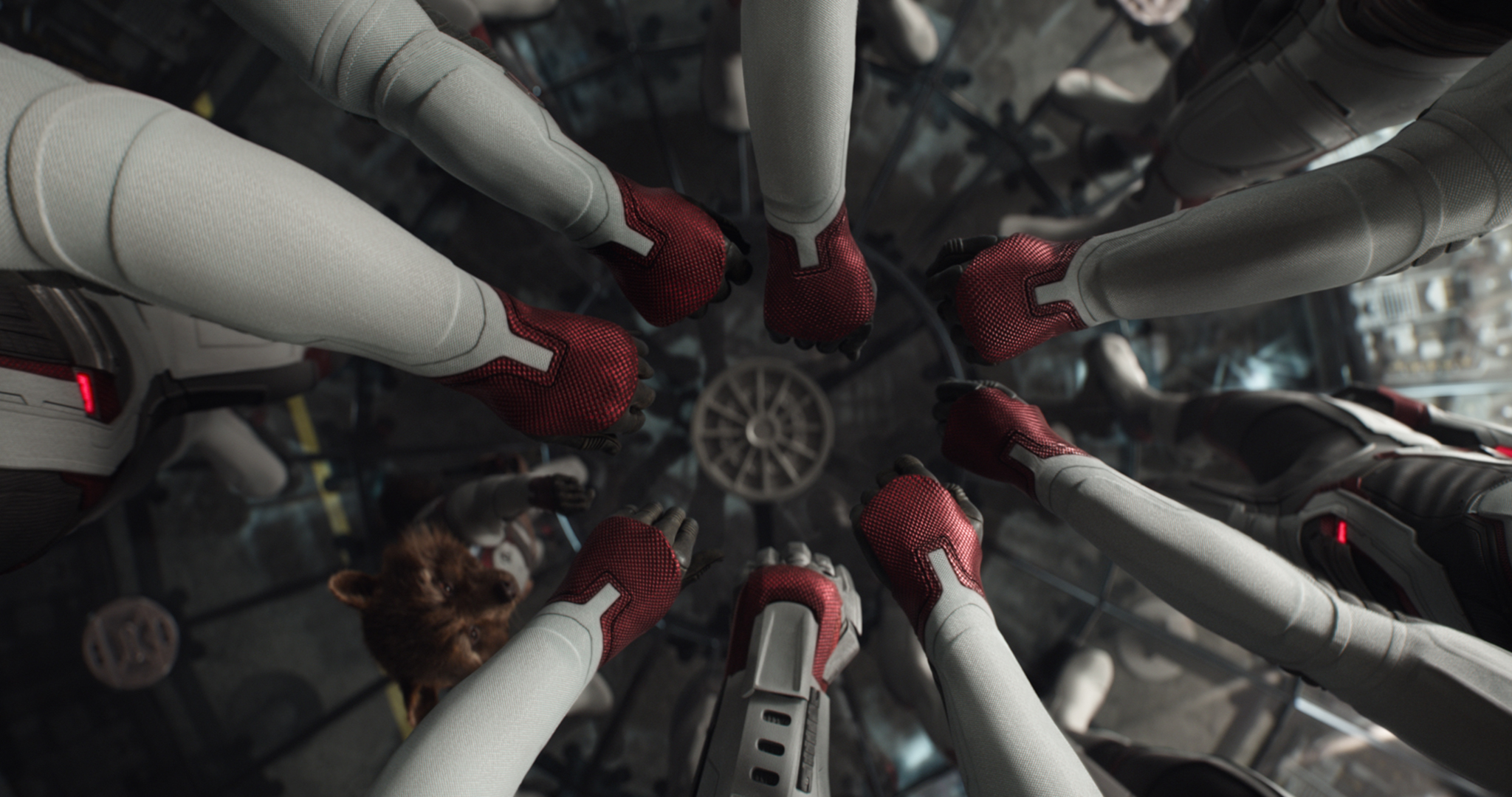
Let’s say they steal the Space Stone from Tony Stark’s father in 1970. Doesn’t that mean that Tony Stark’s father was never able to study the Stone, thus he never creates the Arc Reactor technology that Tony later uses to power the Iron Man suit? And Iron Man is never born? This is basically a version of the Grandfather Paradox of time travel: Travel back in time to kill your grandfather, and then you are never born — hence you are unable to kill your grandfather.
Well, not in this movie! This movie version of time travel isn’t quite what most moviegoers are used to. For example, the rules of the butterfly effect where changing one tiny aspect of the past will alter the future in unpredictable ways — think Back to the Future or this famous Simpsons episode — aren’t in place.
READ MORE: How to Stream Every Single Marvel Movie
Nor is there a time loop. For example, in Harry Potter and the Prisoner of Azkaban, the characters who travel back through time know exactly what they need to do in the past because it’s already happened in the future. (For example, future Harry and Hermione know they have to hit their past selves with rocks because they already felt themselves being hit with rocks at the time.) They also know they will tear apart their world if they diverge from that strict plan.
If the Avengers change something in the past, they create a parallel timeline
Time travel in Avengers: Endgame is based on a popular time travel theory in the field of quantum physics. At one point, Iron Man even drops the name David Deutsch — that’s the guy who came up with the “Many Worlds Theory” or “Multiverse Theory.” Basically, he argues that the place we conceive of as our universe is just one of many parallel universes. And if you change something in the past, you create a new timeline, branching out from the original timeline. So nothing they do in the past affects their main timeline.
For example, in the original timeline, Loki was captured and taken to Asgard by Thor in 2012. In Endgame , the 2023 Avengers accidentally facilitate Loki’s escape with the Tesseract (the Space Stone). But when they travel back to the future, Loki hasn’t used the Stone to wreak havoc for a decade. That all happened in a separate timeline. This logic eliminates the option of simply traveling back in time and killing Thanos as a baby, as Rhodes suggests, because it would not change their future, only an alternate universe.
But they have to return the Infinity Stones to their original places
The Ancient One (Tilda Swinton) insists that in order to maintain the reality of each universe that they visit, the Avengers need to return the Infinity Stones to the places they found them after they are done using them. It’s fine if they create separate timelines, but if they deprive one timeline of the gems that maintain its reality, then they essentially break that timeline. Captain America does return all the stones at the end of the movie. (He also returns Mjolnir, the hammer that Thor took from Asgard, back to Thor’s home planet for the same reason.)
Nebula can kill her past self and still survive
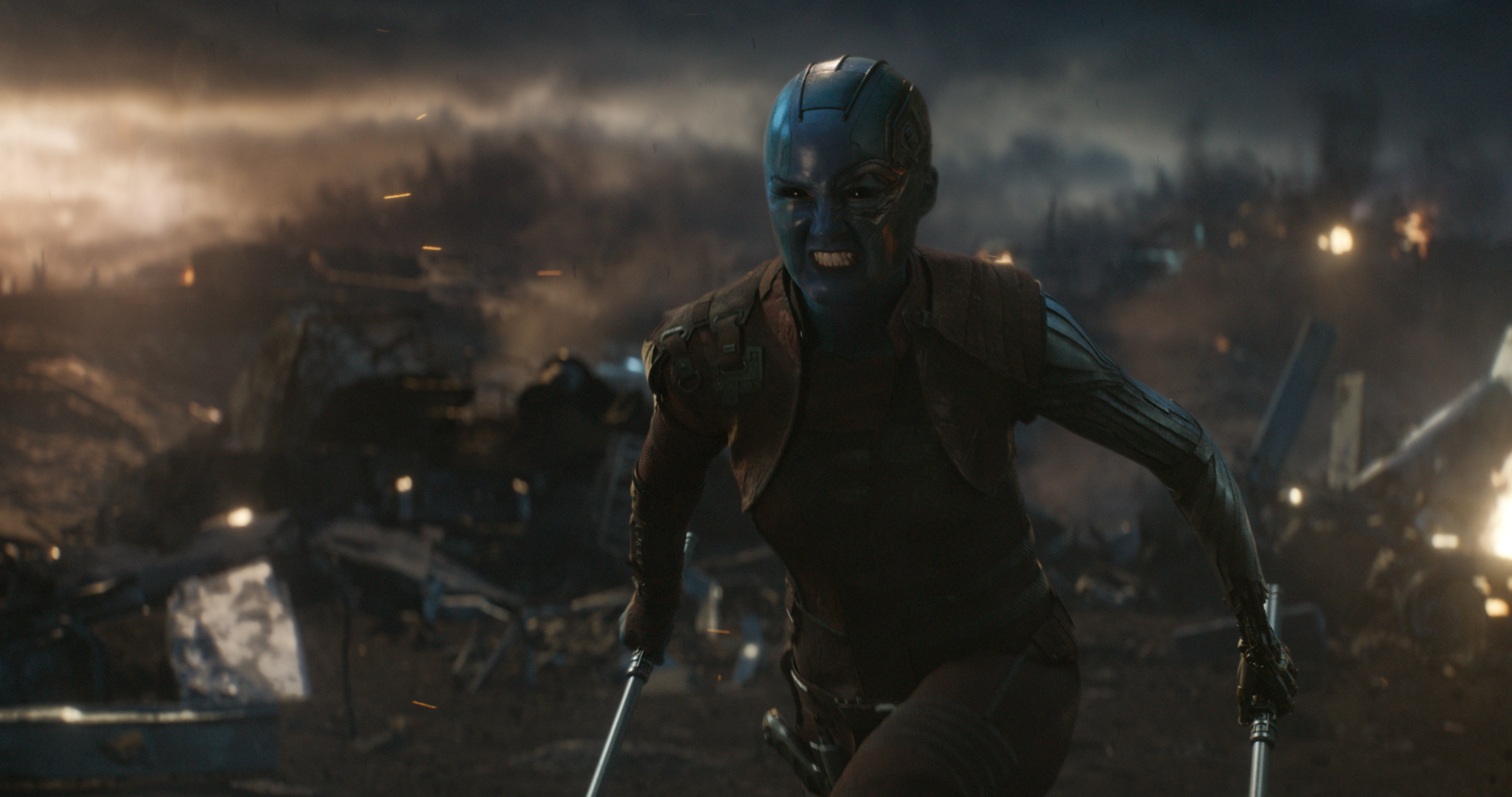
The movie contains an extreme example of why parallel timelines are different from the butterfly effect. Toward the end of Endgame , the new, good Nebula (Karen Gillan) from 2023 shoots and kills old, evil Nebula from 2014. And though you might expect 2023 Nebula to start bleeding out or disappear, she’s completely fine. That’s because when 2014 Nebula traveled to the future on Thanos’ orders, she created a split timeline. Thus these are two different Nebulas who exist on two different timelines. What happens to one does not directly affect the other.
Captain America was married to Peggy all along
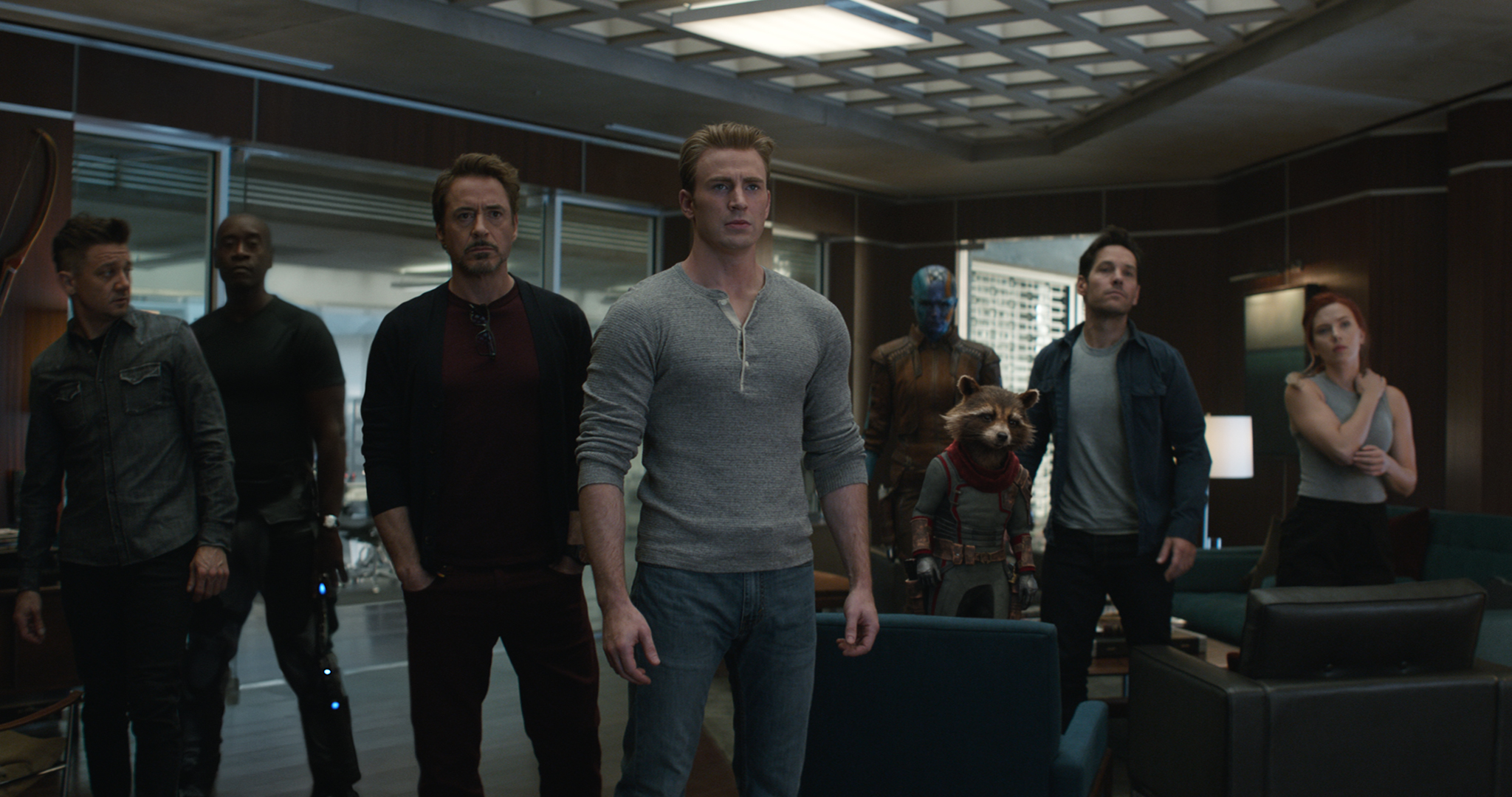
Remember when I said earlier that there were no time loops? That’s not entirely true. There is one time loop that seems to work differently from time travel in the rest of the movie. I don’t know why. It just does.
Mid-way through the movie, Hulk promises the Ancient One that he will return the Infinity Stones to their original places in space and time. At the end of the movie, Captain America goes back in time to do this. But instead of returning after five seconds, like he agreed upon with Hulk, he stays in the past.
A few seconds later, Bucky and Sam (Anthony Mackie) see an old Captain America sitting on a nearby bench. We see in a flashback that after returning the Infinity Stones, he goes back to live out a quiet life with Peggy. We see them dancing together in their shared home.
According the logic of the movie, Captain America didn’t actually create a new timeline. If he did, he wouldn’t have been able to return to that same bench. He just lived out what had always happened to him. He was always married to Peggy (Hayley Atwell).
Back in Captain America: Winter Soldier, Peggy mentions a husband, though she never reveals his name. In a video that plays on a loop at the Captain America exhibit, Peggy says, “[Steve Rogers] saved 1,000 men, including the man who would become my husband, as it turned out. Even after he died, Steve is still changing my life.” She looks down after saying this, perhaps evasive — probably because said husband was, in fact, Steve.
Later, when Steve visits her hospital bed, we see pictures of children but none of her husband — presumably because that would give away who her husband was. Tellingly, Peggy says in that scene that “none of us can go back.” She then forgets that Steve is there — because at that point, she’s suffering from Alzheimer’s — and exclaims, “You came back!” He replies, “I couldn’t leave my best girl. Not when she owes me a dance.” Likely this is a parallel to the off-screen reunion that happens when Steve travels back in time to find Peggy.
As long as Steve maintained his false identity and didn’t interfere with anything in the past that would bring the Avengers to their fight with Thanos (like saving Bucky from being brainwashed by HYDRA) the timeline stays stable. The other version of Steve still wakes up in 2012 after being frozen during World War II and still joins the Avengers. Older Steve watches on from afar. It’s unclear whether the two Steves would have encountered one another at Peggy’s funeral: They were both alive when it happened during Captain America: Civil War , but perhaps they were both there and the younger version simply didn’t recognize the older version or his fake moniker.
Everything happened the way it did because it had to, according to Doctor Strange
Doctor Strange suggests in Infinity War that the Avengers could only beat Thanos in one possible future out of millions. In Avengers: Endgame , he tells Tony Stark, “If I tell you what happens, it won’t happen.” Given that the Avengers defeat Thanos at the end of the battle (and Doctor Strange not-so-subtly flashes one finger at Iron Man during the fight), we know that we are seeing that one single future in which the Avengers defeat Thanos.
Knowing that, old Steve would resist meddling in the Avengers’ affairs so that they would eventually win their fight against the big purple baddie.
More Must-Reads from TIME
- Iran, Trump, and the Third Assassination Plot
- Ellen DeGeneres’ Unfunny Netflix Special Leaves So Much Unsaid
- Welcome to the Golden Age of Scams
- Did the Pandemic Break Our Brains?
- 33 True Crime Documentaries That Shaped the Genre
- The Ordained Rabbi Who Bought a Porn Company
- Introducing the Democracy Defenders
- Why Gut Health Issues Are More Common in Women
Write to Eliana Dockterman at [email protected]
The Avengers: Endgame Timeline, Explained
Here's exactly how Marvel's time travel works, how it doesn't, and what it means for the future of the Cinematic Universe [This Article Contains Spoilers].
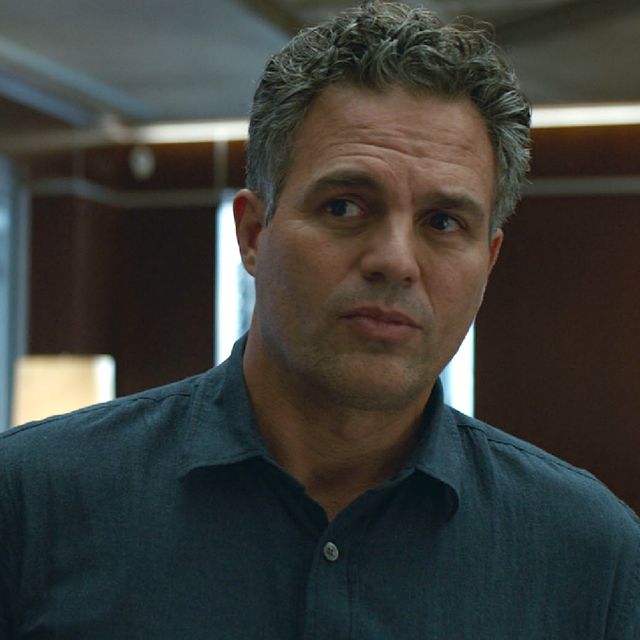
Editor's note: There are spoilers in this story.
Most fans leaving the theater after Avengers: Endgame will likely spend the next few days lying awake at night trying to figure out time paradoxes and drawing out visual aides of timelines. The time travel theories the MCU introduced with its latest movie are complex, but within the comics, heroes and villains have actually been jumping between both time and space for decades. It's part of what's most exciting about the vast world that thousands of creators have had a hand in building, but also why translating something like time travel to the screen can ultimately be incredibly confusing.
Time Travel in Avengers: Endgame
In Avengers: Endgame , the Ancient One explains to Banner that each of the Infinity Stones help keep the core timeline in place. But if the Avengers remove them, they'll create splinter timelines that would hypothetically each continue alongside the original one. The technical term for this would be a multiverse, and that's something that has existed for almost the entire history of the Marvel comics continuity. But when Banner convinces the Ancient One to give him the Time Stone, he theorizes that returning all the Stones back to their rightful places in time will mean that the timeline has been rectified, meaning that nothing in the timeline should be out of place.
By the end of the film there are a lot unknowns in the MCU's version of time travel. And their meddling with the past fundamentally changes the entire universe in ways our heroes couldn’t have possibly predicted.
Another part of why the Avengers exploration of time travel feels so strange is that, unlike the whirling cosmos of the Marvel Universe in the comics, the MCU has largely attempted to stay away from the complex nature of the multiverse. Intergalactic heroes like the Guardians and Thor have been more interested in adventures and scavenging than solving the cosmic mysteries of the universe.

Time Travel in The Marvel (Comics) Universe
Over the natural course of thousands of comics, the idea of a multiverse has been used to explore and explain away the often narratively muddled Marvel Universe, while also giving creators a chance to delve into numerous realities and possibilities. To explain the concept behind the Ancient One's warning, we have to go back to the earliest days of the Marvel’s fictional comic universe to hundreds of thousands of years ago when the Infinity Stones were created.
During the the "Thanos Quest" storyline it's established that the Infinity Gems, as they were known in the books, were the remnants of an ancient entity from before recorded time. According to what Thanos saw in the Infinity Well, this all-powerful being was the only living thing in any and all realities. The loneliness of this omnipotent solitude led the entity to kill itself, but out of the ashes of their death came the six Infinity Gems, which held the all the power of their former self. Eagle-eyed fans might remember that this origin was briefly summarized and reimagined in the MCU by the Collector in Guardians of the Galaxy .
But if we look back to the comics, that scope, alongside time travel has long been a part of the shared storyline of some of our favorite heroes and their most fearsome villains. Kang the Conqueror is one of the Avengers' most notorious villains and one of Marvel's most prolific time travelers. The iteration that we see of Hulk in Endgame —a smart merging of both sides of Bruce Banner—has to face down an evil future version of himself known as Maestro. Time travel is a tangible thing that scientists can access, and heroes can utilize. In the comics it is accepted that it exists and almost always has. That influence is felt here in Endgame with the sudden inevitability of time travel.
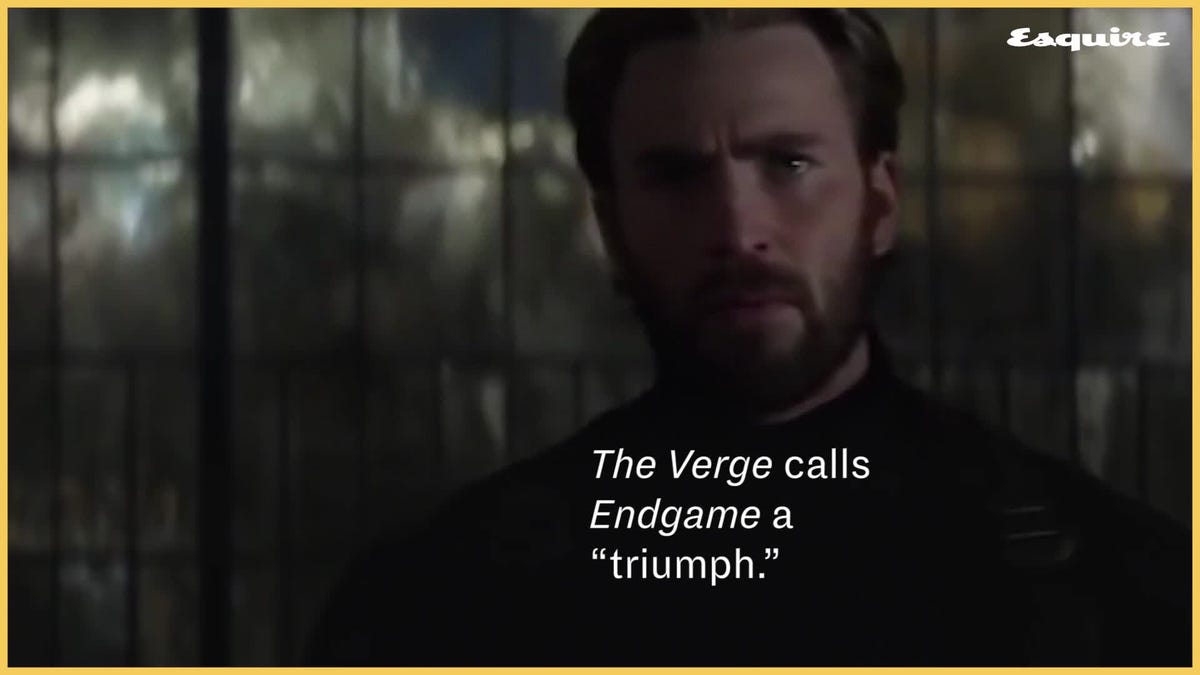
The Problem With Time Travel in Avengers: Endgame
In the world of the MCU, Banner's plan to put the Infinity Stones back where they found them kind of works. After Tony dusts Thanos and his army, the stones and the universe are theoretically safe.
Unfortunately, the film also contradicts its own version of time travel. When the Avengers go back in time to try and secure the Stones, Thanos' actions in the Infinity War dusting aren't immediately changed. When they gain all of the stones, however, Banner is able to bring the vanished back into existence by thinking on it and snapping his fingers. But surely the simple act of taking the Stones at all would've meant that Thanos would have never been able to collect them all and dust half of the world in the first place, right? Well, not quite, because what it seems like the MCU is actually presenting here is one fluctuating singular timeline.
An ever changing but singular timeline is the only way that the film's events would make any sense. It appears that the directors want us to believe that the impact of the events were such that they happened during the films we have already seen, without changing the future in 2024.

It's a messy set of rules that seem to shift depending on the needs of the story. The Russos and Feige are essentially taking a leap of faith, relying on the fact that the suspension of disbelief is needed from viewers—as if it wasn't a stretch from aliens and trees fighting an evil extraterrestrial threat to time travel being real.
The Future of Time Travel in the MCU
It's highly probable that this is just the beginning of the MCU's exploration of time travel, and Bruce's hashed-together plans might have much larger ramifications. For example, Loki's escape is a fact that is likely to be revisited in his upcoming Disney+ series, which will now probably center on the God of Mischief causing havoc throughout time and space with the cosmic cube. The tesseract has been a key part of the MCU, so this should affect the world as we know it. These moments will have an impact outside of the cinematic universe as Cap's arrival with a shiny new shield for Sam means that his Disney+ series will now focus on his tenure alongside Bucky as Captain America rather than as Falcon.
If we are to imagine that every action has an equal and opposite reaction, there's a chance that all the Avengers' time-shenanigans have just opened the door to some of Marvel's most famous dimension hoppers... the Fantastic Four and their notorious enemy, Victor Von Doom. Kang the Conqueror could be lurking in the shadows waiting to take advantage of the timescape, or maybe we will see the return of the omnipotent Adam (Warlock) who was introduced at the end of Guardians of the Galaxy Vol. 2 , and has in the comics wielded the gems. For now, let's hope that the interdimensional rift caused by Endgame doesn't create too many problems as 2020 still doesn't have any heroes lined up with no MCU films on the release slate.
Marvel New Releases 2024: Marvel Studios & Disney Projects

Marvel’s ‘Thunderbolts*’ Trailer Is Finally Here
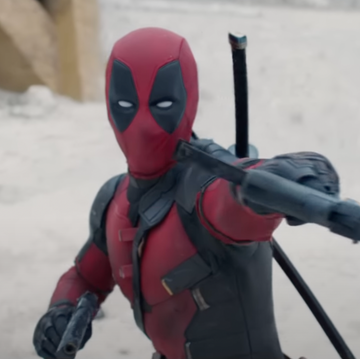
Every Marvel Studios Project Announced So Far

Marvel Cinematic Universe Movies, Ranked
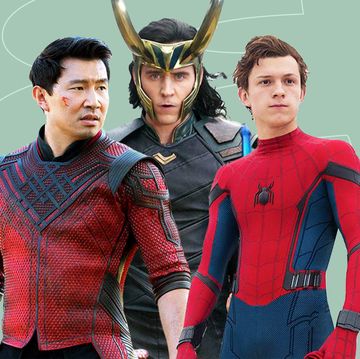
Where to Watch All 34 Marvel Movies In Order

Disney+'s MCU Shows, Ranked

The 'Loki' S2 Trailer Pulled Me Back Into the MCU

Aaron Taylor-Johnson Is a Badass Kraven the Hunter
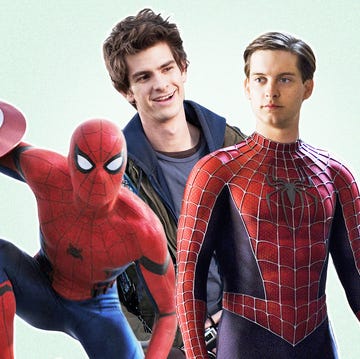
Every 'Spider-Man' Movie, Ranked

It Was Aubrey All Along!
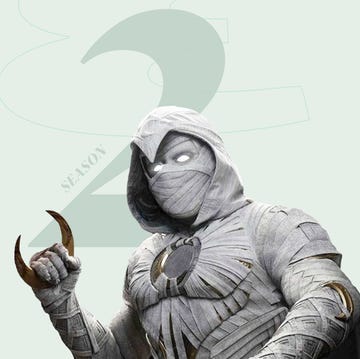
Everything We Know About 'Moon Knight' Season 2
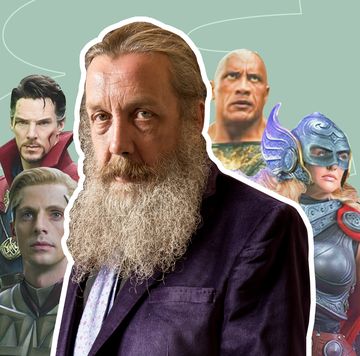
Alan Moore is Still Bashing Superhero Movies
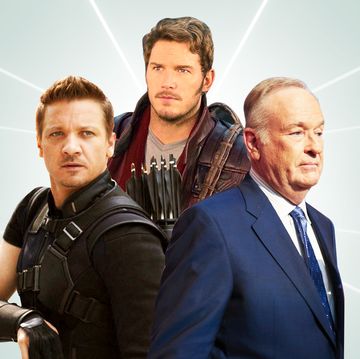
The 25 Worst Characters in the MCU, Ranked
- Search Please fill out this field.
- Newsletters
- Sweepstakes
Avengers: Endgame explained: The logic behind the heroes' master plan
Here's how the Marvel epic's internal science avoids paradoxes
Anthony is a Senior Writer for EW.
Professor Hulk and The Ancient One do their best to make it clear, but moviegoers may still be coming out of Avengers: Endgame wondering about a key plot point.
How are the heroes able to avoid creating a looping paradox?
Let’s break down of the internal logic of the story …
***Spoilers Below Loki***
If Thanos from 2014 gets dusted in the future, then he isn’t around to do The Snap in 2018, right?
But if he’s not around to do The Snap, then the heroes never go on the mission that results in 2014 Thanos’ death — which means he survives and causes The Snap after all.
This is the peril of time travel, the possibility of an endless logic loop, doubling back on itself and undoing itself ad infinitum.
That’s why the plan the Avengers come up with isn’t about rewinding the clock.
Basically, don’t think of it as time travel. It’s dimension hopping.
According to the script by Christopher Markus and Stephen McFeely, you can’t go back in time in your own dimension. If you do, you just end up with older or younger versions of yourself. (That’s what happened to Ant-Man. They pushed time through him.)
Think of it literally as a movie — that’s easy to do, right? It’s a continuum, and you can’t rewind your own film while you’re still moving forward. But — you can hop out of your Blu-ray and into a player spinning another disc and land at any point in that copy of that story.
That’s what the heroes do. To put it another way, they copy and paste reality.
That’s why The Ancient One explains to Bruce Banner that removing the stones basically ruins her own timeline. Why is her DVD existence any better than his DVD existence?
That’s why he promises to return the stones, to cause as little disruption to these other worlds as possible. If they can do that (as Captain American says he does at the end) those branched timelines realign with the central timeline — let’s call it the Prime Timeline — and it’s like the stones never left.
When the three teams jump back in time, they’re really jumping to three other screenings of the movie.
When Thanos 2014 — the Thanos from the time of the first Guardians of the Galaxy movie — gets wind of their plot and travels forward in time to show up above upstate New York five years after the snap, he’s a different Thanos.
He can die there in a cloud of dust without creating a paradox in that timeline because he’s a visitor from another copy of the movie.
However, yes, back in his own Blu-ray, he’s now dead and The Snap never even happens. That remains a branch that can’t realign with the Prime Timeline because it has changed too much.
Loki vanished in the Avengers 2012 timeline when he grabbed the Tesseract, so even though he remains dead in the Prime Timeline, he is free to make mischief in this other branched timeline. (Expect that to be where this character’s upcoming Disney+ series is set.)
The Gamora from 2014 who ventured forward in time with Thanos and her still-evil sister Gamora has ended up trapped in the new timeline, but the Gamora we already know is still dead, sacrificed to the Soul Stone.
Gamora 2014 has no memory of any of the Guardians of the Galaxy experiences, or Peter Quill, or any of it. That Gamora is gone. New Gamora could still be a part of Guardians of the Galaxy Vol. 3 . Just expect her to have a significantly different personality.
This is also why Nebula can kill her 2014 self without disappearing. She’s not killing herself from the past, she’s killing a counterpart from another Blu-ray. To draw another metaphor, think of it like Toy Story , when Buzz Lightyear meets another Buzz Lightyear toy. It’s a version of him, yeah, but a different one from the Buzz we know.
Again — that separate 2014 timeline then branches off without Thanos, no Nebula, and also absent Gamora.
When Captain America goes back to return all the borrowed gems, he stays behind not in the past we know, but technically in a different branched reality.
Basically, he goes to live in another copy of the movie.
More on that soon from directors Joe and Anthony Russo….
Related content:
• EW unveils The Original Six covers for Avengers: Endgame • The Avengers are brutal to each other in this 2012 interview • All for One: EW’s epic and emotional sit-down with the Avengers who started it all
Related Articles
‘Avengers: Endgame’: How time travel works in the MCU
- Copy Link URL Copied!
Warning: Not even time travel will save you from “Avengers: Endgame” spoilers if you continue to read this post. That’s just not how it works in the Marvel Cinematic Universe, or the real world.
In “Avengers: Endgame,” the heroes who survived the events of “Avengers: Infinity War” attempt to undo the damage caused by Thanos and his Infinity Stones-powered “snap” in order to save their friends and the universe.
Unfortunately, by the time the remaining Avengers track down Thanos, the now retired Mad Titan had already destroyed the Infinity Stones and their one shot at bringing everybody who was wiped out in the Decimation back to life.
Or so they think.
Thanks to Scott Lang, aka Ant-Man, and his accidental imprisonment in the Quantum Realm , the team figures out that time travel is the key to setting everything right. Despite his initial refusal, Tony Stark’s brilliant mind can’t help but resolve the science and create the technology required to make time travel a reality. The Avengers’ time heist to collect all the Infinity Stones from the past is a go.
But forget everything you learned from movies like “Back to the Future” or “Terminator” or even “Hot Tub Time Machine.” The MCU has its own rules about time and time travel as explained by the Hulk and the Ancient One during “Endgame.”
Even more spoilers for “Avengers: Endgame” ahead.
‘Avengers’: Every MCU movie ranked in order of significance to ‘Endgame’ »

Watch the trailer for “Avengers: Endgame.”
How is time travel possible?
As explained in the “Ant-Man” films , the Quantum Realm is a place where the normal rules of time and space don’t apply.
Scott spent five years in the Quantum Realm and for him it was just five hours. Janet van Dyne, on the other hand, spent 30 years lost in the Quantum Realm and it seems she experienced it as a full 30 years. There is clearly plenty that remains unexplained about this dimension.
That said, it turns out individuals are able to enter the Quantum Realm at a specific place and time and travel through it to exit back to reality at a completely different place and time — so long as they have the proper equipment.
In “Endgame,” the key components are Pym particles, which allow the Avengers to become so small that they are able to enter the Quantum Realm, and the special time GPS invented by Tony, which navigates each time traveler to the when and where of their destination.
Does altering events in the past affect the future?
No. According to Hulk, whatever you do while in the past can’t affect the events that have already happened in your timeline because that’s not quite your past anymore. So things like the grandfather paradox or the butterfly effect are not really concerns in the MCU.
The Ancient One later helpfully creates a visual showing how going to the past and removing something like an Infinity Stone can cause timelines to branch out and create alternate, parallel futures. Think multiverse theory .
If stealing the Infinity Stones from a specific time creates alternate timelines, how are the Avengers able to return to their future?
That time GPS is really handy for navigating all possible time and space through the Quantum Realm, even between timelines.
‘Avengers: Endgame’: Who died and who survived? A guide »
Why does Captain America need to return all of the Infinity Stones?
In order to retain the integrity of 2012 Ancient One’s timeline, 2023 Bruce Banner promised to return her Time Stone.
This is because according to their conversation (with handy visual guide as mentioned above), returning each Infinity Stone to the exact moment in the timeline that they are stolen would make it as if they had never left the timeline. Meaning, the branched out alternate timeline would cease to exist.
Returning each Stone is the only way to make sure that the 2023 Avengers don’t accidentally doom an alternate timeline at the expense of saving theirs.
“Endgame” doesn’t quite explain how returning each Stone would negate everything a 2023 Avenger did in the past they visited, but it does.
But doesn’t altering events in the past have no effect on a future?
Supposedly.
What about how the 2023 crew accidentally gives 2012 Loki the Tesseract and allows him to escape?
Theoretically all of that happened after 2023 Captain America swiped Loki’s scepter with the Mind Stone. So Cap returning the Mind Stone should somehow negate that event. (Probably?)
Does 2014 Thanos traveling to 2023 with his entire army and engaging in that big battle have any repercussions?
Same rule as above, in theory. Since Nebula and Rhodey had already left that timeline with the Power Stone, the timeline with that specific 2014 Thanos would cease to exist once Cap returns the Stone to the temple on Morag.
But what about when 2023 Nebula knocked out 2014 Star-Lord? She did that before they grabbed the Power Stone.
Maybe he wakes up in time to still grab the Power Stone before Korath gets to it.
Would returning the Soul Stone to the correct time bring back Black Widow?
It appears the soul-for-a-Soul-Stone trade is permanent. Or at least irreversible even with the power of the Infinity Gauntlet.
This suggests just returning the Soul Stone also would not help undo Black Widow’s sacrifice.
But it might not be the last fans see of her. In comics, the Soul Stone houses a pocket dimension called Soul World, where the souls of those sacrificed for the Stone reside.
The existence of Soul World was teased at the end of “Infinity War,” where Thanos visits the soul of a much younger Gamora. If Widow’s soul is also in Soul World, perhaps there is still a way to save her. Maybe Adam Warlock will be a factor.
So why didn’t they just grab a Black Widow from a different point in time?
Probably because she wouldn’t be the same Black Widow. And because as heroes they couldn’t justify disrupting or harming another timeline by kidnapping their Widow. Or maybe because the movie was already three hours long.
Does Captain America choosing to live out his life in the past affect the future?
Nothing in the past 21 MCU films indicates that it was impossible that a 2023 Steve Rogers was secretly living his own life as the other events in the films were happening. Maybe he was always there, just waiting for that exact moment in 2023 to pop back into the Avengers’ lives again as an old man chilling on a bench with a Vibranium shield.
Are you sure all of this makes sense?
Please direct all further questions to Kevin Feige c/o Marvel Studios.
Twitter: @tracycbrown
More to Read
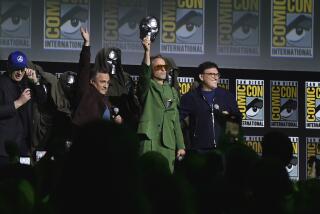
Robert Downey Jr. reveals how Kevin Feige persuaded him to return as Doctor Doom
Aug. 22, 2024

At Comic-Con, Marvel hits the reset button with Robert Downey Jr., Fantastic Four
July 28, 2024
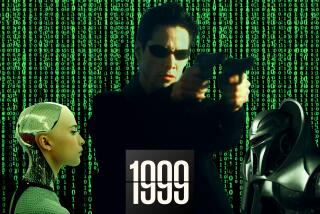
The movies went soft on AI. ‘The Matrix’ reminds us why it’s so dangerous
March 31, 2024
The biggest entertainment stories
Get our big stories about Hollywood, film, television, music, arts, culture and more right in your inbox as soon as they publish.
You may occasionally receive promotional content from the Los Angeles Times.

Tracy Brown is a reporter for the Los Angeles Times covering television, film and other pop culture.
More From the Los Angeles Times
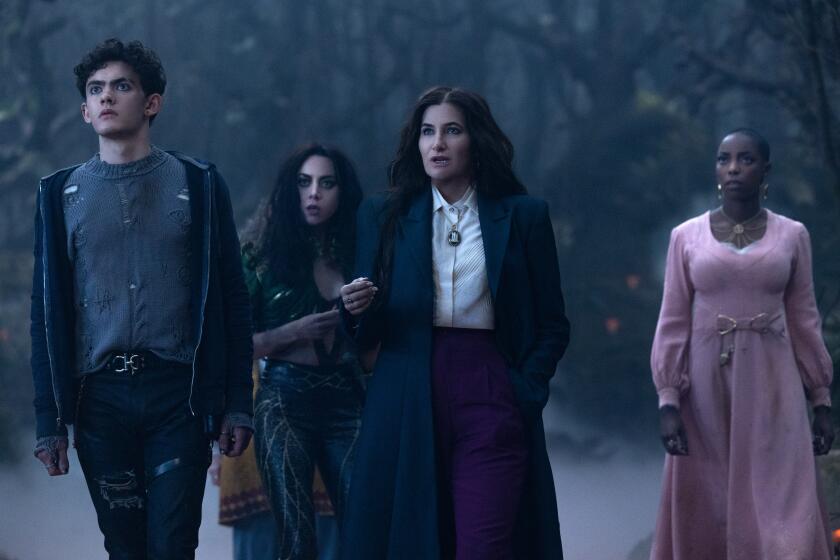
‘Agatha All Along’ requires minimal Marvel homework, but these backstories explain more

Hollywood Inc.
SAG-AFTRA calls strike against ‘League of Legends,’ the latest move in video game actors’ battle
Sept. 25, 2024

Travel & Experiences
Universal rolls out its first all-female monster maze. Here’s why it matters for horror
Sept. 23, 2024

This TV writer crafted her most powerful narrative yet — in the form of a board game
Sept. 19, 2024
Most Read in Entertainment & Arts

17 actors, writers, directors and ‘SNL’ alumni choose their top sketch of all time

From gentle ‘Heartstopper’ to romantic ‘Romeo,’ Kit Connor wants to show his range


Diddy and Kim Porter’s children blast alleged memoir attributed to their late mother

Reality star Julie Chrisley resentenced to 7 years in bank fraud and tax evasion case
How ‘Avengers: Endgame’ Spins a Web of New Timelines

Your changes have been saved
Email is sent
Email has already been sent
Please verify your email address.
You’ve reached your account maximum for followed topics.
10 Great Movies Recommended by Jackie Chan
Is there going to be an ‘uglies 2’, the 10 best 1990s comedies almost no one remembers.
Spoilers ahead for Avengers: Endgame .
Time travel is a bitch of a narrative device. Like a wild horse, it'll buck off any and all comers, no matter how well they think they have the idea buttoned down. At first glance, such appears to be the case again in Avengers: Endgame . By the end of the story, too many things have gone wrong, too many moments in the past have been driven directly off the rails. There is no way the timeline is an intact Mobius Strip. This is no Kate And Leopold where the past and the future happen in tandem, meaning any time travel was supposed to happen and therefore no paradoxes can come into play due to the inertia of time itself. Then again, what if that wasn't the goal? Instead of a Mobius Strip, it looks like the Russo Brothers may be utilizing another time travel staple: The Trousers of Time.
For those of you who aren't fans of author Terry Pratchett (shame on you!), let me explain: the Trousers of Time is just a simple way to explain a multiverse. Trouser, or pants as I'll be calling them from now on because I'm an American, begin as a single unit near but then split into two sleeves. The other portions can touch, they look identical, but they are two separate things. The best possible scenario for Endgame is the MCU is now functioning on two timelines. Worst case scenario is they just made Trousers of Time for an eldritch beast with 800 legs.
Let's look at the rules established by the film. Changing something in the past doesn't change the future. However, if the time travelers don't put the Infinity Stones right back where they got them from, time will splinter into new offshoots. Tilda Swinton 's Ancient One only gives BruceHulk ( Mark Ruffalo ) the Time Stone once she is certain he understands the danger. Did he though? Yes, Steve Rogers ( Chris Evans ) took the Stones back to where they came from. But even if he also went back and undid a couple of fumbles during the Time Heist, the pants have already split.
First of all, Loki ( Tom Hiddleston ). During the initial attempt at grabbing the Tesseract, the Avengers' plan goes south when the Asgardian Prince snatches the briefcase and teleports away. There is no putting that oopsie-daisy back in the bottle. Loki is long gone. Capturing him and sticking him back in the timeline is not within Captain America's wheelhouse. And this is not the bittersweet, emotional growth Loki that MCU audiences have grown to love but the one still covered in a thick layer of villainy. Which might be a problem in and of itself, but let's focus on how this new wrinkle in time ripples out into the greater narrative.
Loki escaping means he is never returned to Asgard. He is never imprisoned in the dungeons so he's not there to "make mischief" when the Dark Elves break-in. Without that, Frigga ( Rene Russo ) might survive the assault. But it also means Thor ( Chris Hemsworth ) had no one easily on hand to help him reach the Dark Elves' homeworld of Svartalfheim. There's a possibility this timeline sees Malekith ( Christopher Eccleston ) succeeds in his mission to absorb the Aether and attacked Asgard.
But that time split is nothing compared to the big one: Thanos (Josh Brolin). In the final act of Avengers: Endgame , Nebula 2 ( Karen Gillan ) uses the Time Heist machine to bring her father and his army forward in time to fight. The villains disappear from the beginning of the first Guardians Of The Galaxy movie, prior to Star-Lord ( Chris Pratt ) obtaining the Power Stone. They never return. Thanos' gambit does not pay off and his entire military might is dusted. His minions, his Generals, everyone. Perhaps the only survivor is Gamora 2 ( Zoe Saldana ) who is now trapped in the MCU Prime timeline. That is going to have massive reverberations.
On a small scale, it means Star-Lord 2 will never meet his Gamora. Without her, Rocket 2 ( Bradley Cooper ) and Groot 2 ( Vin Diesel ) simply collect the bounty on Star-Lord 2 and move on with their lives. Drax 2 ( Dave Bautista ) never enters the picture. Star-Lord probably escapes but he isn't part of a new found family. The events of Guardians Of The Galaxy Vol. 2 never happen, or if they do it is probably Star-Lord would simply choose to join his father, Ego the Living Planet 2. ( Kurt Russell )
The overshadowing change though is the void left by Thanos 2. He is just gone from the universe. It's possible Ronan ( Lee Pace ) survived since he was already on another mission, but a majority of the army is wiped out. Thanos never destroys Xandar to retrieve the Power Stone. He never wipes out most of the Asgardian refugees (and there most likely wouldn't be any since Loki isn't there in that timeline anyway to push events towards Odin's ( Anthony Hopkins ) death and Hela's ( Cate Blanchett ) release). He never kills Heimdall ( Idris Elba ). Knowhere isn't destroyed. The Soul Stone is never retrieved. The battle in Wakanda never takes place. The Avengers never make up after the Age Of Ultron in order to be strong enough to fight Thanos. The Snap never happens. If there's no Thanos to defeat, there's no reason for Black Widow ( Scarlet Johansson ) to die. The consequences of killing Thanos 2 in the wrong pant leg of time has repercussions that reverberate up and down the timeline.
Comic books have never shied away from the concept of a multiverse and Into The Spider-Verse proved the MCU is willing to at least flirt with the concept. But it is the upcoming Disney+ Marvel shows that telegraph a split timeline is probably in the near future. Looking at the line-up all but confirms the television shows will be taking place in MCU2.
First there's WandaVision starring Elizabeth Olsen and Paul Bettany . Unless Bettany is only visible to Wanda through Infinity Stone magic or the show takes place in the short timeframe between the end of Ultron and the beginning of Infinity War , they are definitely in MCU2. The same for Loki starring Tom Hiddleston. Wherever Loki 2 absconded to when he stole the Tesseract is the likely suspect as the narrative jumping off point for his show. Hawkeye will see Clint Barton ( Jeremy Renner ) passing the baton on to Kate Bishop, a story which could take place in either the MCU or MCU2. But if they want to use Matt Fraction' s amazing run as the show's baseline, that works best in a reality where Clint isn't a married father of three. The Falcon and the Winter Soldier could be a natural extension of Endgame 's final moments, but not calling Anthony Mackie "Captain America" when he has both the shield and the blessing of the original superhero seems off. If this tale is indeed from the MCU2, the question of where Steve Rogers might be is a nail-biter.
Finally, Disney+ announced an animated series called Marvel’s What If...? which will delve into alternative histories, such as what would happen if Peggy Carter ( Hayley Atwell ) was given the super soldier serum instead of Steve. This could be entirely separate from the continuity of the films and live-action television shows. But with Endgame shaking out the way it did, there's a distinct possibility all these loose time threads being explored were caused by the Time Heist.
What do you guys think? Did the Russo Brothers merely leave plot holes in their time travel narrative, or were these purposeful choices setting up the next phase of the MCU?
Note: This article was initially published at a prior date, but in advance of Avengers: Endgame’s release on Digital HD on July 30th, we’re highlighting our spoiler-filled Endgame content .
For more on Avengers: Endgame , click on the links to our recent articles below:
- 'Avengers: Endgame': The Russo Brothers Explain How Cap Could Lift Mjolnir
- How ‘Avengers: Endgame’ Succeeds as a Distinct Film from ‘Infinity War’
- ‘Avengers: Endgame’: Robert Downey Jr. Initially Didn’t Want to Say That Final Line
- ‘Avengers: Endgame’: Here’s Why Katherine Langford’s Big Scene Was Cut
- Entertainment
- The Avengers (2012)
All The Time Travel In Avengers: Endgame Explained
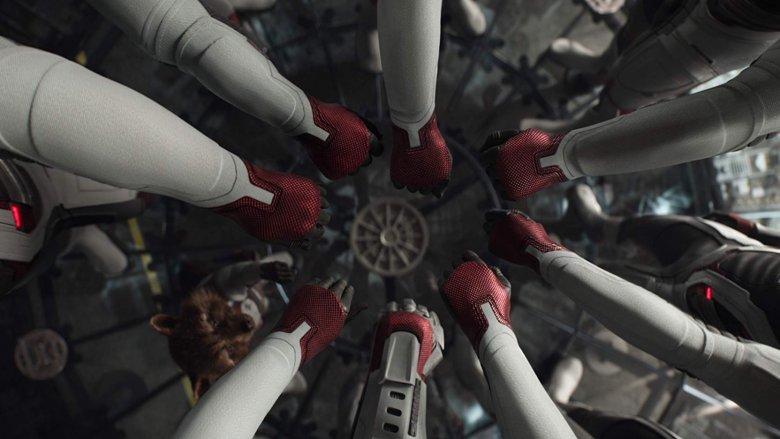
One of the biggest questions surrounding Avengers: Endgame leading up to its release was how exactly Earth's Surviving Mightiest Heroes were going to bring back their snapped comrades. We knew at least some of them would come back, of course (Black Panther's not about to bow out after just one solo film), but what we didn't know was how. Well, now that the film is here, we know that one of the most prominent theories surrounding that question — time travel — was correct.
So, how does time travel work in the Marvel Cinematic Universe? What are the implications of it spinning out of Endgame ? What's left of that tech in the universe? We're here to talk about all that and more as we break down the various threads, branch realities, and conundrums that came with the MCU's first foray into spacetime adventuring.
Oh, and in case you hadn't figure this out already, there are MAJOR SPOILERS for the entire film ahead.
The inspiration
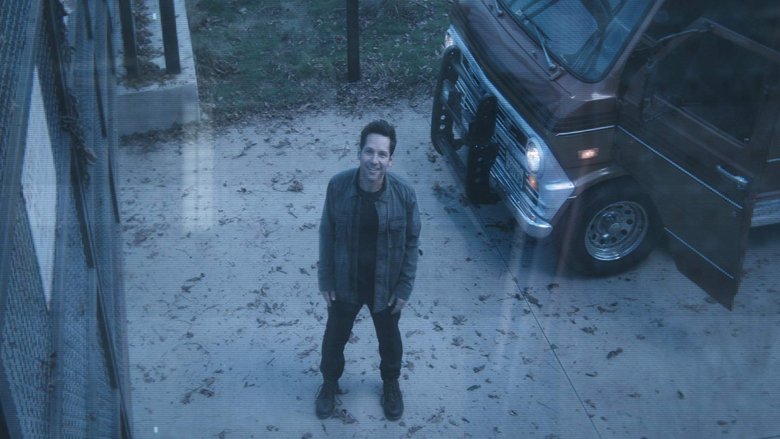
As many fans theorized in the months leading up to the film, the Quantum Realm visited in Ant-Man and the Wasp did indeed have a major role to play in Avengers: Endgame , and it all began when Scott Lang returned after being trapped there for five hours, only to discover that five years had passed on Earth. Scott's time travel idea was based on this simple observation of his predicament: If time works differently in the Quantum Realm, and the Quantum Realm is in fact its own pocket reality, can it be used — with Pym Particles as the shrinking agent — to leave our universe at one point in time and come out at a different point?
When Tony Stark initially dismissed the idea, Scott, Steve Rogers, and Natasha Romanoff turned to Bruce Banner for help, and he believed he could make the idea into something practical. Using the Quantum Tunnel designed by Hank Pym, Bruce tried to send Scott back in time by only a week. But instead of pushing Scott through time, he pushed time through Scott, leading to strange backwards and forwards aging issues. It did technically result in at least a little bit of time travel, but another big brain had to refine the idea to make it something usable.
An idea refined
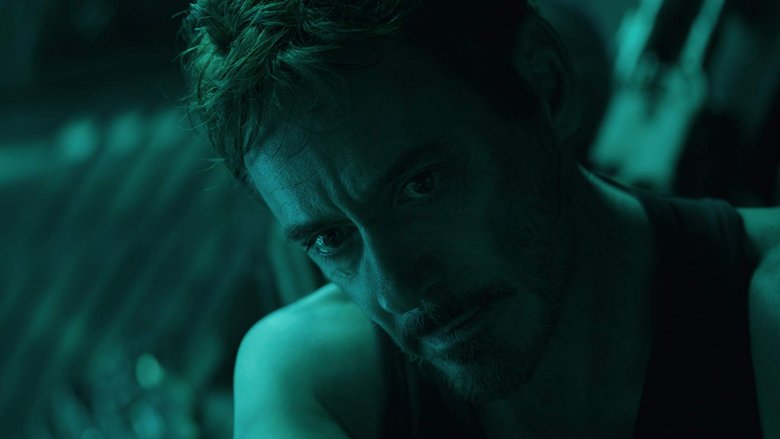
Tony Stark's initial reluctance to collaborate on the time travel idea wasn't just scientific in nature. It was also personal, as Tony was unwilling to risk losing the family he'd built in the process of altering the past. Tony's mind wouldn't stop working, though, and after running some models, he realized he had a working formula for a "spacetime GPS" that would allow the Avengers to harness the quantum access granted by Scott and Hank Pym's work. With this new tech in hand, they could navigate the Quantum Realm to a specific date and a specific place.
Picking targets was the next great obstacle, and Black Widow pointed out that with the right year, they could collect three different Infinity Stones in New York City alone. So, three travel teams were assembled. Tony, Steve, Scott, and Bruce would travel to New York in 2012 (the year of The Avengers ) for the Space, Time, and Mind Stones. Rocket and Thor would head to Asgard in 2013 (the year of Thor: The Dark World ) to get the Reality Stone. And Natasha, Clint, Nebula, and Rhodey would head to space in 2014 to collect the Power (on Morag) and Soul (on Vormir) Stones. If only it were that simple, right?
The rules of time travel
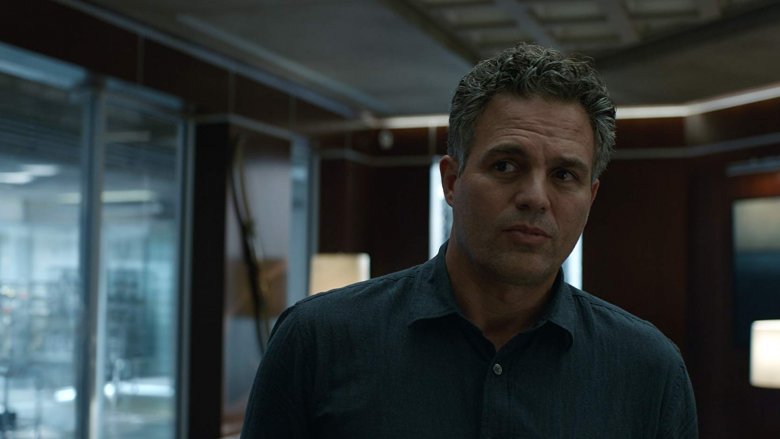
As the time travel discussions began, Scott suggested that everything would be fine as long as they followed "the rules of time travel," meaning no altering historical events or speaking with their past selves or other tampering. Scott and Rhodey later pushed this argument further by mentioning virtually every film about time travel ever made, only to have Bruce cut them short. In the Marvel Cinematic Universe, at least, their "realistic" version of time travel does not work the way many other films have postulated.
According to Bruce, you don't change your future if you visit your past, because when you do that your past becomes your future on your own individual timeline, which means your present is now part of your past, and so on. This is, among other things, why we see things like Captain America fighting himself and even Nebula killing her own past self without wiping her present self from existence. That's simply how time travel works in this world, and that's important to remember in the context of the film's overall plot.
Branching realities
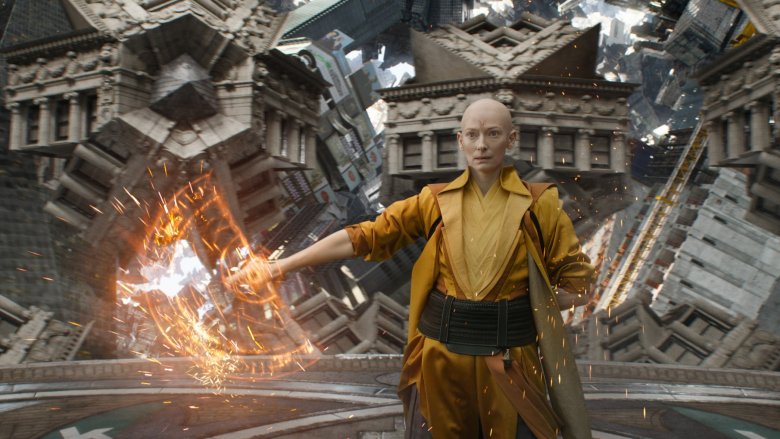
When the New York team arrived in 2012, they split up to snatch the Space, Mind, and Time Stones. It turns out that the Time Stone was actually in New York City at the time of the Battle of New York, though the Avengers of 2012 didn't know it. Bruce Banner travels to New York's Sanctum Sanctorum, where he finds The Ancient One (Tilda Swinton) fighting her own defensive battle as the Chitauri attack rages on.
Bruce tries to explain to her that they need the Stone for their own future purposes, but she declines to hand it over, going so far as to split Banner's consciousness from his Hulk body so they can talk without fighting. As she explains, the Infinity Stones are actually responsible for helping to maintain the flow of time. If you remove one, it creates a "branch reality" in which people will suffer untold chaos in the absence of the Stone, particularly the Time Stone as it serves as the weapon of the Sorcerer Supreme. It's here that Banner makes a key point about the film's use of time travel: The Avengers can't stop the chaos of branch realities, but they can erase them by returning the stone to the exact spot where they removed it from the timeline. When that happens, the branch reality ceases to exist, and so does the suffering it caused. This is why returning the Stones rather than destroying them is so important.
Further back
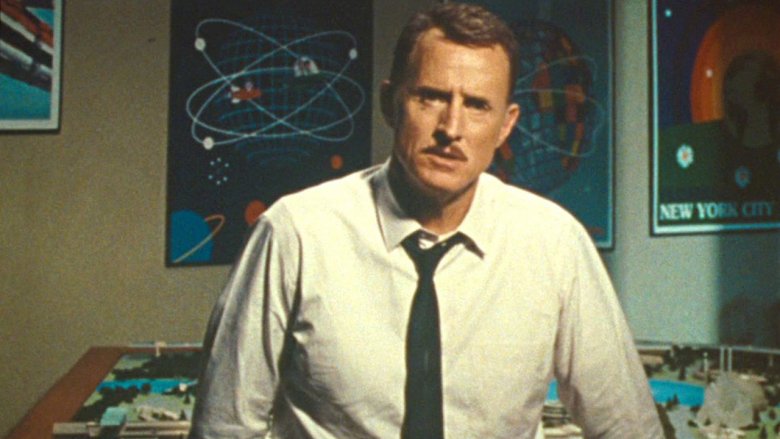
Captain America said before the Avengers started the journey that they should be ready for anything, even when they knew the place they were traveling to, and his words proved prophetic in the hunt for the Space Stone, which in 2012 was still in the form of the Tesseract. Tony Stark had the Stone secure in a case, but was knocked across the room by the 2012 Hulk coming down the stairs, sending the Tesseract sliding across the floor and ... right into Loki's path. The God of Mischief used the Stone to open a portal and escape Asgardian prosecution, leaving Tony and Steve with no Space Stone and only enough Pym Particles for one more trip through the Quantum Realm.
So, Tony came up with an idea: Use those Pym Particles to go backwards again, this time to 1970, when he knew both his own father Howard and Hank Pym would be at a S.H.I.E.L.D. facility in New Jersey. The trip allowed Tony to steal the Tesseract, while also meeting up with his own father just before his own birth. It also allowed Cap to steal more Pym Particles for the return trip, while also getting a little reminder of just how much he loved Peggy Carter.
Two Nebulas, one cybernetic system
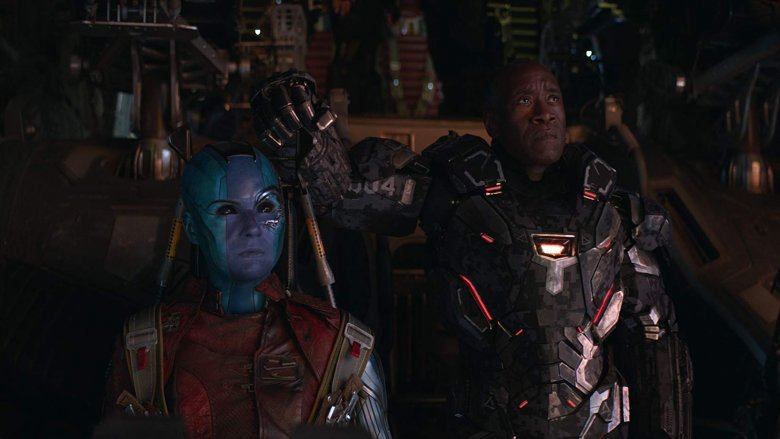
The four-person space team was divided into two two-person teams, with Natasha and Clint heading to Vormir to get the Soul Stone and Nebula and Rhodey staying on Morag to follow Peter Quill's path to the Power Stone. In the process, we learned what happened when a cyborg time travels into the same time she used to live in. When Nebula landed in Morag, she was relatively close to her own 2014 self, and the neural network that existed in both of their brains suddenly became a shared space for two consciousnesses. This not only allowed Nebula to realize that Thanos was growing aware of their plan, but more importantly it allowed 2014 Nebula access to her own future memories. Thanos took full advantage of this, and used those memories to learn exactly what he had to do to get all of the Infinity Stones not with a galaxy-wide search, but by traveling through the Quantum Realm via stolen Pym Particles so he could steal all six from the Avengers in upstate New York after their time heist was complete.
Familiar faces return
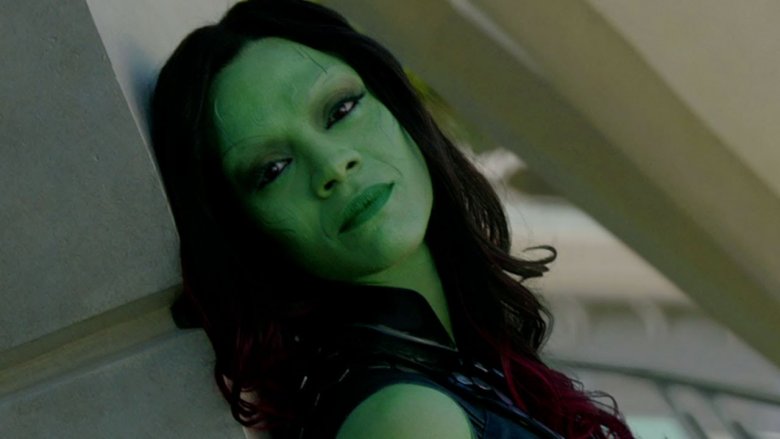
Through the magic of time travel, Avengers: Endgame allowed us to get new glimpses of characters who were seemingly killed off for good in Infinity War . This was particularly exciting when it came to Loki and Gamora, who were found in 2012 and 2014, respectively, showing us parts of their stories from The Avengers and Guardians of the Galaxy we didn't get to see before.
In Loki's case, he used the time travel as an opportunity to snag the Tesseract and disappear into space. In Gamora's, she bonded with a future version of Nebula, realized her place as an enemy of Thanos a bit earlier, and helped keep the Infinity Stones out of his hand when she traveled to the present.
So, what happened to both of them? Well, whatever Loki did with the Tesseract was, according to Bruce Banner's logic, erased when Captain America returned the Space Stone to the point where it was taken. So Loki's timeline stayed relatively intact, meaning he's still dead. In Gamora's case ... well, unless Tony Stark's snap included her (she was no longer part of Thanos' army when he did it), she's out there somewhere, and Star-Lord is determined to find her. Specifically, her past self, who never got to know or fall in love with Quill.
Magic and science
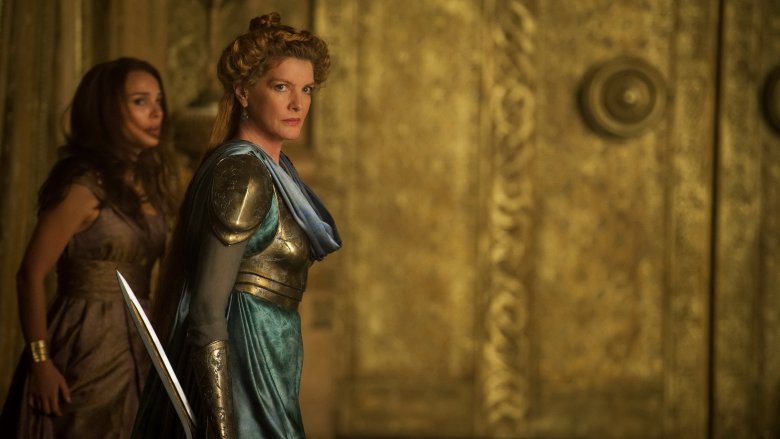
Because this is the first time we've ever seen time travel in the Marvel Cinematic Universe, Avengers: Endgame gives us a fascinating look not just at how it works, but at how it affects the larger world. In more than one of the team's time-travel voyages, that included how magic and various magical characters interacted with the science behind the voyage.
In 2012, Bruce Banner made contact with The Ancient One, and while she didn't immediately seem to sense that he was from the future, she wasn't surprised when he asked for Stephen Strange . She was already aware of Strange's place in the timeline, and was also clearly aware of how time travel and Infinity Stones would interact.
Things got even more interesting on Asgard in 2013, when Thor encountered his mother Frigga on the day she died in Thor: The Dark World . Frigga sensed almost immediately that she was looking at a future version of her son, and when he tried to deny it she noted that she was "raised by witches" and she "see(s) with more than eyes." So, at least some magic users in the MCU, including Doctor Strange, have a clear sense of what time travel looks like, and that could have major implications for future films.
The future of time travel
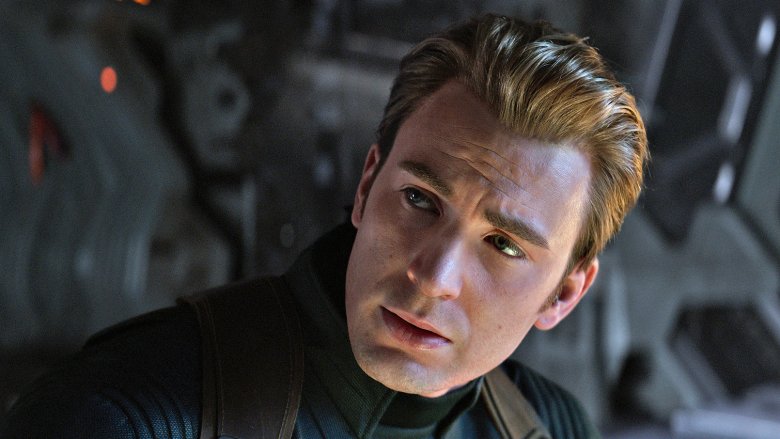
The third act of Endgame features all of the surviving Avengers returning to their compound with the Infinity Stones in hand. And then everything goes sideways when Thanos travels to the future courtesy of Nebula, who has infiltrated the compound with the Pym Particles stolen from her own future self. Thanos' ship destroys the time platform, and then Thanos himself destroys the Quantum Tunnel when he see Captain Marvel trying to make a break for it with the Stones.
That doesn't eradicate time travel from the MCU, though, as we see when Captain America steps onto a brand-new platform constructed by Bruce at the end of the film. Cap uses the remaining Pym Particles to journey back into the past to return the Stones. What this ultimately means is that time travel is not only still theoretically possible, but still practically possible in the MCU. As long as Henry Pym has or can produce more Pym Particles, the Avengers (or someone else) could make jumps through time again in the future.
The First Avenger's second chance
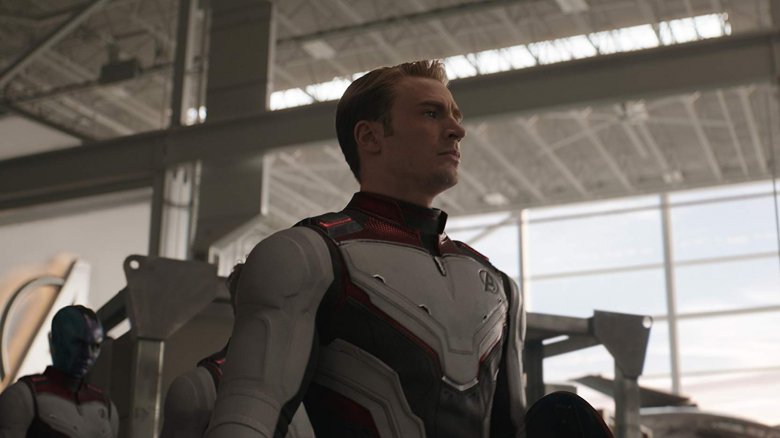
Even after the victory over Thanos, the noble sacrifice of Tony Stark, and the return of all of the Decimated beings to the universe, Avengers: Endgame delivered one more happy ending. Captain America did not simply jump to the past with the Infinity Stones, but returned them and then jumped further into the past to be with Peggy Carter again. That means that, through all the years he was frozen and all the years after he was thawed out, Captain America got to live a semi-regular life while his past self was living out the life we already know in the MCU.
But just how regular was that life? Cap declines the opportunity to fill Sam Wilson in on the past, but we do know that he took Mjolnir, which he'd been proven worthy to wield, and while he brought his repaired shield back to the future with him, he did not seem to bring the hammer. Did he leave it in the past? Did he have adventures with it? Did he and Peggy save the world in their own quiet way during the Cold War? Will we ever see any of those adventures? Cap was coy, but perhaps future MCU stories won't be.
- The Inventory

The quantum mechanics of “Avengers: Endgame,” fact-checked by scientists
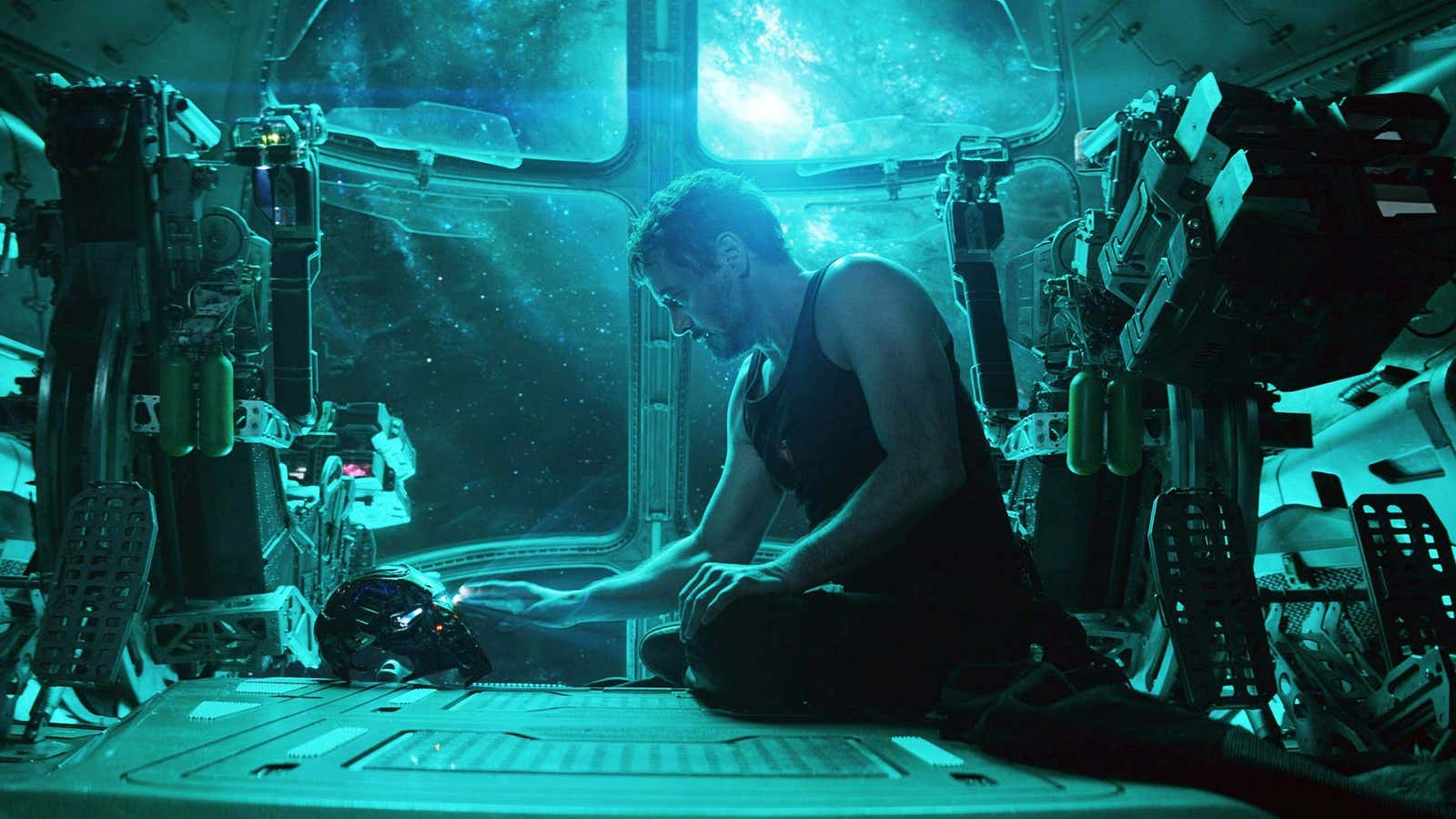
Spoiler alert: This story contains details of the plot of Avengers: Endgame.
At the end of Avengers: Infinity War half the people (including heroes and villains) in the universe were gone in the snap of a finger from Thanos (Josh Brolin).
So how can Avengers: Endgame try to bring them back?
Well, with that tried and tested movie plot device: time travel. Plus a surprising amount of scientific jargon thrown in, including quantum mechanics , Deutsch propositions , eigenvalues , and inverted Möbius strips .
But don’t think that everything you hear during the movie was created in the minds of some crazy screenwriter. Many of the time-travel concepts in Endgame are connected, at least in name, to recent scientific theory, simulation, and speculation.
Let’s dive into the science of quantum time travel and discuss whether eigenvalues can really save the universe.
Time travel 101
The key premise of the movie is that the only thing that can reverse the deaths of half the universe are the things that caused those deaths in the first place: the powerful Infinity Stones .
Problem is, Thanos destroyed these in the present day, so the stones are only available in the past. Retrieving them will require a convoluted journey back in time to multiple locations by the remaining Avengers.
Is time travel actually possible? We’ve known since Albert Einstein posed his Theory of Special Relativity more than 100 years ago that traveling forward in time is relatively easy.
All you need to do is move at close to the speed of light and you can theoretically travel millions or even billions of years into the future within your lifetime.
But could you get back again? This feat appears to be much more difficult. Here are a few challenges and possible solutions.
The grandfather paradox
Traveling back in time can cause apparent logical inconsistencies in reality, like the well-known grandfather paradox .
If you went back in time and killed your grandfather when he was young, then you could never be born, but if you weren’t born, then how did you go back and kill him?
Scientists have several theories about these time loops (physicists call them closed timelike curves ). Some theories state that such loops are just physically impossible and therefore traveling back in time can never happen.
But we know, also thanks to Einstein, that spinning black holes can twist up both space and time , which is why one side of the black hole is brighter than the other in the first picture ever taken of one .
Time travel in Endgame
In the movie, the characters first make fun of many other time-travel movies such as Back to the Future and the Terminator series where changing your own past and future is possible.
Instead, Endgame goes with the alternative reality idea, where any changes back in time cause a whole new universe to be created, a so-called splitting or branching off of multiple timelines. In physics, this idea is called the Many Worlds Theory .
To avoid this problem, the Avengers plan to borrow the stones from past timelines, use them in the present day, but return them to exactly the same moment once they have finished with them. But will it work?
Enter quantum mechanics
Quantum mechanics is mentioned a lot in the movie and there are in fact many emerging theories about quantum time travel , including some that potentially solve the grandfather paradox .
In quantum mechanics, atomic particles are more like indistinct waves of probability . So, for example, you can never know both exactly where a particle is and what direction it’s moving. You only know there is a certain chance of it being in a certain place.
A British physicist named David Deutsch, who is mentioned in the movie, combined this idea with the Many Worlds theory , and showed that the grandfather paradox can disappear if you express everything probabilistically .
Like the particles, the person going back in time only has a certain probability of killing their grandfather, breaking the causality loop. This has been simulated successfully .
This might seem strange, and while some of the jargon used in the movie may seem a little over the top, you can be sure that real quantum science is even stranger than movie makers could ever imagine. It’s clear that even scientists are struggling to make sense of the implications of quantum theory.
Terminology for effect
The time-travel theory scenes (of which there are several) are filled with technical jargon, some out of place and some in the right ballpark.
Here are a few of the terms we hear in the movie concerning time travel:
Eigenvalues
In discussing their approach to time travel, characters Tony Stark and Bruce Banner mention eigenvalues . This is most likely an example of movie math talk for effect, as eigenvalues are a fairly low-level (basic) concept in linear algebra.
Verdict: A case of the math mumbles
Planck scale
The Planck scale is all about very small things. Planck length, time, and mass are base units used in physics. A Planck length is 1.616 × 10 −35 m. That’s very small.
It is the distance that light travels in one unit of Planck time—which is also a very small amount of time. Given the movie is about quantum mechanics-based time travel, chatting Planck scales don’t seem too far off topic.
Verdict: Planck has a point.
Inverted Möbius strip
The time-travel jargon also discusses inverting a Möbius strip. A normal Möbius strip is a surface with only one side. You can create one easily by taking a strip of paper, twisting it once, and then sticking it together.
Although a Möbius strip has a range of interesting mathematical properties, its technical relevance to time travel is tenuous, beyond some high-level attempts to explain the grandfather paradox.
Verdict: Twisting theory a little.
From a scientific perspective, it’s intriguing to have a new movie with such a heavy plot foundation in time travel, and the movie doesn’t pull many punches in diving straight into both the jargon and implications of various time-travel scenarios.
While some of the mathematical terminology is clearly there for effect, the plot makes a reasonable effort to adhere to current high level-thinking about time travel—to a point.
Time travel is one of those captivating scientific concepts that is perhaps furthest from implementation by scientists, and so its pivotal role in a movie about superheroes who can fly, go subatomic, destroy universes, and change reality is perhaps particularly apt.
This article is republished from The Conversation under a Creative Commons license. Read the original article .
📬 Sign up for the Daily Brief
Our free, fast, and fun briefing on the global economy, delivered every weekday morning.
Den of Geek
Avengers: Endgame Ending Explained
The Avengers: Endgame ending might seem a little confusing and...well, it is. We're here to help.

- Share on Facebook (opens in a new tab)
- Share on Twitter (opens in a new tab)
- Share on Linkedin (opens in a new tab)
- Share on email (opens in a new tab)
This article consists of nothing but massive Avengers: Endgame spoilers. You’ve been warned. We have a completely spoiler free review right here.
Avengers: Endgame , like any other movie dealing with time travel, can be a little confusing when it comes time to wrap things up. The more you think about how time travel works in this movie, the more it makes your head hurt. But, since you’re already here at this article, it’s probably too late for you anyway. Fortunately, the time travel elements only directly affect the endings of Thanos, Tony Stark, and Steve Rogers, while whatever is next for Thor, the Guardians of the Galaxy (the Gamora problem notwithstanding, which we’ll get into), and the rest of the gang is relatively straightforward.
But you can’t really deal with the Avengers: Endgame ending without at least trying to figure out the headachey rules of time travel (which we’ll go into in much more thorough detail in another article). Most time travel narratives featuring characters traveling into their own pasts follow one of two time travel logics. The first logic is that time travel is a closed loop and that anything you change through traveling back in time will have always been changed. Everything that’s happened in the past has already happened, even if you didn’t know it until your current present. The second option is the branched parallel timelines logic. If you travel into the past, every change you make will create a new branch of the timeline that exists in parallel to the “original” branch. In this logic, you can never change the present and future of your own timeline, only the present and future of other timelines. Which logic does the time travel in Endgame fall into? Kind of both, but mostly the second.
Ad – content continues below

The fact that the Infinity Stones are stolen from the Avengers at various points in the timeline, even if they are returned, implies there are multiple timelines that were created from those changed moments. In other words, parallel universes would branch out from Steve, Tony, and Scott’s jump to Battle of New York in 2012; Steve and Tony’s jump to New Jersey in 1970; and from Rhodes, Clint, Nebula, Scott, and Nat’s jump to 2014. So keep all that in mind as we sort out the events of the Avengers: Endgame ending.
We tried to explain all of the Avengers: Endgame time travel rules right here. Maybe that will help with the rest of this.
THE DESTRUCTION OF THANOS’S ARMY
This parallel branches theory, which is alluded to in Tony Stark’s final voiceover about the multiverse, is perhaps better explained by Thanos’s time travel. If he travels to his own future (the Endgame present) and dies before ever assembling the Infinity Gauntlet and snapping in the first place, then the Avengers’ original need to stop him would become irrelevant… only if this were a closed loop timeline. Since that didn’t happen, this implies that there are parallel branch universes that our heroes and villains are jumping between, but those branches are “clipped” (Steve’s word) when the Stones are returned to their place in the timeline.
Tony Stark uses the reality altering power of the Infinity Gauntlet to wipe out Thanos, the Black Order, and their entire army, just as Thanos wiped out half of all life in the universe at the end of Avengers: Infinity War . Of course, the destruction of the Thanos of “five years ago” in the “present” of the current MCU opens the door to all manner of headaches, but the simplest explanation here is that the Thanos that Thor beheaded early in the movie is still “our” Thanos, while the one defeated at the end of the movie is from a parallel universe, which might help explain why his demise doesn’t invalidate the next few years of the MCU.
DEATH OF TONY STARK
The seeds of Tony’s death by Infinity Gauntlet have been teased since at least 2014’s Guardians of the Galaxy , when Ronan the Accuser disintegrated because he couldn’t handle the energies contained within the Power Stone, and was thus consumed. Just a little earlier in Endgame , it was clear that the power of the Gauntlet and the combined stones could barely be contained by the Hulk’s gamma-irradiated physique, so if he couldn’t handle it, the minute Tony had to use it, we should have all been clued in to his imminent exit from the land of the living.
read more – Marvel and MCU Easter Eggs in Avengers: Endgame
We suppose you could say that there’s some symmetry with killing off Tony Stark, the character who made the entire MCU possible thanks to Robert Downey Jr.’s performance, and the late 2018 death of Stan Lee , the legendary writer, editor, and co-creator (and master of cameos) of many aspects of the Marvel Universe as a whole. In both cases, an era has passed.
Get the best of Den of Geek delivered right to your inbox!
WHO IS AT TONY STARK’S FUNERAL?
In attendance at Tony Stark’s funeral you can find all the surviving Avengers, plus a few special guests, including Cobie Smulders’ Maria Hill, Marissa Tomei’s May Parker, William Hurt’s Thaddeus Ross, and Ty Simpkins’ Harley Keener from the immensely underrated Iron Man 3 .
We wrote in much more detail about the significance of all the guests at Tony Stark’s funeral right here.
WHAT’S NEXT FOR THOR, VALKYRIE, AND THE GUARDIANS OF THE GALAXY?
Believe it or not, the Asgardians of the Galaxy is actually a thing in Marvel Comics . Somehow. Don’t expect that to be anything other than a clever pun in the MCU, though, as that team consists almost exclusively of characters who haven’t been (and probably never will be) introduced on screen.
However, the prospect of Thor galivanting around the cosmos with the Guardians of the Galaxy is certainly a fun one. Thor: Ragnarok fed off the colorful, comedic energy of the Guardians movies, and Chris Hemsworth has proven himself a natural comedic presence, with fun timing and chemistry with Chris Pratt. Whether this is the direction James Gunn chooses to go with Guardians of the Galaxy Vol. 3 or not remains to be seen, as he has been pretty good about keeping his movies partitioned off from the wider concerns of the MCU. It’s more likely that Thor 4 will take on a similarly interstellar tone to Thor: Ragnarok , one that sees Thor finally recover from the depression that gripped him after losing Asgard, the events of Infinity War , and his actions at the start of Endgame . The prospect of Valkyrie running the show in New Asgard should leave fans hopeful for a larger role for Tessa Thompson in future Marvel movies, as well.
read more – Which Avengers: Endgame Deaths are Permanent?
But the bigger problem for the Guardians is Gamora. The Gamora we all knew from the first two Guardians movies most certainly died in Infinity War , leaving us with the Gamora of five years ago (or, well, the Gamora of an alternate timeline from five years ago) who never had these experiences with the Guardians. But the ending of Guardians of the Galaxy Vol. 2 set up the arrival of Adam Warlock , a character who has traditionally been tied quite closely to the Soul Stone. Is it possible that through assorted shenanigans, Warlock is able to bring that back into existence, and in the course of that adventure, the essence of the “original” Gamora ends up merging with the one currently running around the MCU? Who knows? We wrote much more about what happened to Gamora in Endgame right here.
In any case, Guardians of the Galaxy Vol. 3 is going to be the first of that arm of the franchise to have to deal heavily with story and character elements introduced in the rest of the MCU. We’ll see how James Gunn and company handle it when the time comes.
SAM WILSON IS THE NEW CAPTAIN AMERICA
Make no mistake, Sam Wilson is your next Captain America . Sure, there have been other characters who took up the shield in the pages of Marvel Comics before Sam got his turn, notably characters like the ill-advised John Walker and everyone’s favorite best pal/ship Bucky Barnes. But here’s the thing…
Steve Rogers never got a say in either of those two characters getting the shield. John Walker was appointed by the US Government after Steve went rogue (as he is known to do from time to time), and Bucky only put on the red, white, and blue while Steve was dead (he got better). To be clear, when Steve returned from the dead (as he is also known to do from time to time) he still gave Bucky his blessing to continue for a while before he took the shield back, but in terms of “officially” passing the mantle on, the only person he has ever done that for is Sam Wilson.
read more: Marvel Movies Watch Order – An MCU Timeline Guide
And with good reason. Even though Bucky pre-dates Sam by nearly thirty years in comics, Sam has been active for far longer, and did plenty of service as Cap’s partner. Steve officially giving Sam the nod here is a big deal. Still, this is very much only the beginning of Sam’s journey to becoming Captain America. There’s a The Falcon and The Winter Soldier TV series coming to Disney+ that will likely deal with Sam getting comfortable with the responsibility that comes with the Captain America title, and Bucky will presumably help him navigate that.
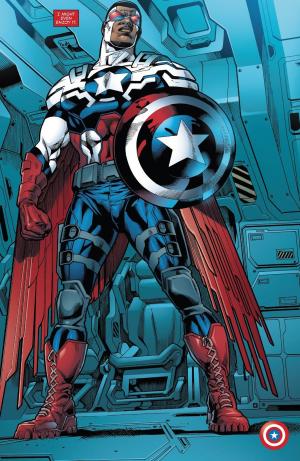
Oh, and the other good news is that Sam Wilson’s Captain America costume is really, really badass, and the MCU version won’t have to make too many modifications to make it work on screen.
WHAT HAPPENED TO STEVE ROGERS?
As the Ancient One explained to Bruce Banner, removing the Infinity Stones from their place in the timeline causes branching issues, but returning them to the moment from which they were taken means that the branching in question never happens. So Steve has six stops to make, including in 1970 (from where he and Tony swiped the Tesseract), 2014 (where the Power Stone was located), Asgard in 2013, Vormir in 2018 (soul), New York in 2012 (time), and…this is where things get cloudy. Where does the Mind Stone get returned to? Because at a certain point in the past, this could potentially allow Vision to return to life.
read more: Avengers: Endgame Review – A Brilliant MCU Finale
But while Steve is only gone for a few minutes of “our time” he’s gone for considerably longer of “his” time. And he decides to take a detour back to 1945, the point shortly after he went into the ice, to live out his days with Peggy Carter. The song playing as Steve and Peggy dance is “It’s Been a Long, Long Time,” specifically the version recorded by the Harry James Orchestra with Kitty Kallen on vocals. “It’s Been a Long, Long Time” was a 1945 hit with lyrics that are really, really appropriate, as they seem to deal with welcoming a lover back from years at war. I’m not crying, you’re crying.
Steve lives out his days with Peggy (and outlives her by a few years, as she died in Captain America: Civil War ), and returns to the spot where he left to let his buddies know that he’s ok, apparently wearing the same tan jacket he wore as young, pre-super soldier serum Steve in Captain America: The First Avenger . He doesn’t look bad for a guy who is about 110 years old, all things considered. And there is still some precedent from the comics for Steve Rogers to still be a part of various Marvel adventures, even if he isn’t taking an active, physical role .
One potential headache here comes when you look too closely at Peggy Carter’s story arc. We know from other MCU films that Peggy eventually married someone else — someone Steve rescued in his big The First Avenger rescue mission. Perhaps Peggy was playing coy and she meant it was Steve himself? Perhaps she married someone else either to lose him in some way (or dump him upon Steve’s return)? Or maybe Steve successfully changed the past here? Or, more likely, after all the other Infinity Stones were returned, he simply created an alternate timeline where he lived out his life with Peggy, and found a way to return to the spot of his disappearance in “our” universe both to reassure his friends and to pass on the shield to Sam.
Latest Movie reviews
Megalopolis review: francis ford coppola rages against time, super/man review: christopher reeve documentary makes you believe he really could fly, the substance review: the horror movie you need to see this spooky season.

Regardless of whatever explanation you choose, just know that Steve Rogers and Peggy Carter get the “happily ever after” that they so desperately deserve. May we all be so lucky.
WHAT ABOUT SPIDER-MAN?
During Tony Stark’s final voiceover, we see Peter Parker returning to school, where he’s greeted by Ned Leeds, who is the same age he was when we last saw him in Spider-Man: Homecoming and Infinity War . And we saw in Spider-Man: Far From Home that many of Peter’s other classmates, including Flash Thompson are back, as well. There seems to be some confusion about why Peter Parker’s friends are still the same age as he is when there has been a five year time jump, but it’s not that hard to explain.
Anyone who survived the snapture aged as normal over the next five years. Anyone who was “dusted” is returned at the same age they were five years previously. The key to this comes in the moment when Hulk is about to use the Infinity Gauntlet, when Tony tells him not to “just bring everybody back, don’t change anything else about the last five years.”
DOES AVENGERS: ENDGAME HAVE A POST-CREDITS SCENE
No, there’s no post-credits scene. Why? Because this movie doesn’t need one. Instead, this movie has a pre-credits scene, which plays kind of like an alternate post-credits scene from Avengers: Infinity War , dealing with what Hawkeye sees when the snap happens. Marvel has the next ten years to set up future movies with fun little teases, they just ended this decade beautifully. What, you were expecting Wolverine to show up? Nah. Marvel Studios takes enough heat for the commercial nature of these post-credits scenes, letting Endgame actually end the way it does is a wonderful thing.
read more – What’s Next for the MCU After Avengers: Endgame?
But that doesn’t mean you should leave as soon as the credits roll. If you are patient and stay to the end and listen very carefully during the very end of the credits, you can hear a faint clanging sound. That is the sound of Tony Stark forging the Mark I armor in the first Iron Man movie. We wrote more about the significance of this here.
“You can rest now.”
Watch everything Marvel and more with a FREE Disney+ TRIAL , right here!
'Avengers: Endgame' Time Travel Explained: How Hulk Clears Everything Up
HULK SAY: STOP WATCHING 'BACK TO THE FUTURE!'
Of all the Marvel characters to explain why you shouldn’t worry about time travel paradoxes, you reasonably can’t expect it to be the Hulk. Bruce Banner , sure. The Hulk? No way. Yet, that’s exactly who explains away all of the potentially confusing time travel problems in Avengers: Endgame.
Spoilers for Avengers: Endgame ahead.
As fans guessed , the Avengers use time travel as the way to retrieve all the Infinity Stones when just taking them from Thanos became a dead end. So the Avengers revisit some of their past adventures in order to get the Stones back.
Thus, Avengers: Endgame becomes a surprise a celebration of the Marvel Cinematic Universe as it takes moviegoers on a victory lap through the unseen edges of films like The Avengers (2012), Thor: The Dark World (2013), and Guardians of the Galaxy (2014). (Apologies to Marvel TV, you still don’t exist.)
But because the Avengers are taking the Infinity Stones from specific times and places, this poses quite a few issues. Namely, if you remember from literally any other movie dealing with time travel, this could mean drastic changes in the timeline. See DC’s Legends of Tomorrow for a weekly lesson.
So, the Avengers’ plan shouldn’t work. But what the Hulk — who merged with Bruce Banner (Mark Ruffalo) to become a version of what the comics called “ Professor Hulk ” — and Tony Stark (Robert Downey Jr.) discover in Endgame is that, actually, it does.
But how? The secret: It doesn’t matter. The Hulk says as much.
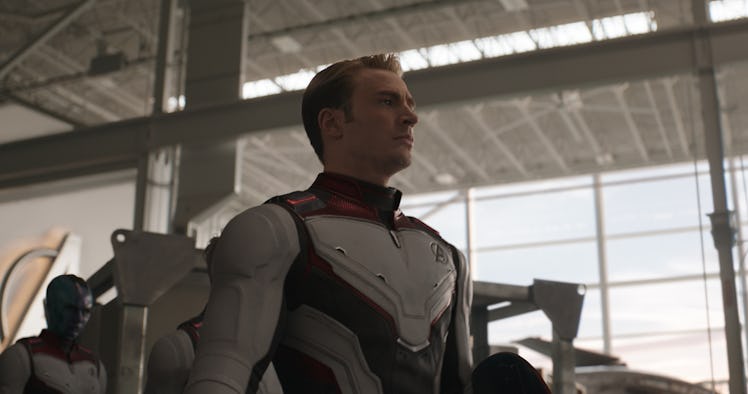
The Avengers do exactly what fans predicted and time travel throughout 'Avengers: Endgame.' But it's the Hulk who addresses every concern you might have.
In the film, when time travel becomes the Avengers’ only option, the Hulk waives off concerns from Rhodey (Don Cheadle), the de facto voice for the audience in the room.
We, being obsessive moviegoers who are attuned to the rules of time travel thanks to a million science-fiction stories, are likely asking the same questions Rhodey is rattling off: Won’t taking the Infinity Stones away from the timeline change time itself? Wouldn’t it undo the snap? Why can’t the Avengers just kill Baby Thanos?
In another movie, these questions would provide all the stakes for the film. But this being Avengers: Endgame , a movie big, bold, and brave enough to challenge Back to the Future as possibly “bullshit,” the film proposes that none of the typical time travel rules matter for the story.
Hulk doesn’t quite get into the specifics of how time travel works in the Marvel Universe, and that’s Endgame ’s greatest weapon.
While there is a general rule with the Infinity Stones, in that plucking them away from their proper time and place can create dangerous new realities (which adds to the urgency of the Avengers’ mission), the film’s comical over-explanation for everything else, as it comes from a salt and peppered dad bod Hulk, ultimately says just one thing: Quit thinking about it, you nerd.
Yes, the film does have a rhyme and reason to how time travel works and it is established to be functionally dangerous. But how Avengers: Endgame stands apart from all other time travel movies (which the characters joke about, in a prime example of lampshading ) is how it doesn’t care for all the typical rules. Because imagine how much of a boring ass movie Avengers: Endgame would be if the heroes were dealing with the same problems seen in every episode of Doctor Who .
Hulk’s dialogue that dismisses all the usual questions about time travel, such as “Your past becomes your future,” is less about making sense of time travel and more about making sense of the very human stories in this superhuman universe. The film’s final shot of two certain characters (you know who) living in happy bliss proves that the Hulk knows what he’s talking about.
Avengers: Endgame is in theaters now.
- Superheroes
- Marvel Universe
Screen Rant
Avengers: endgame's time travel explained by captain marvel's new power.

Your changes have been saved
Email is sent
Email has already been sent
Please verify your email address.
You’ve reached your account maximum for followed topics.
Transformers One's Violence Addressed By Director
Lionsgate reveals official trailer, poster, & release date for new thriller cellar door, halle berry confirms john wick spinoff status amid franchise expansion.
Does Captain Marvel 's time-travel power explain how the Avengers will travel back in time in Avengers: Endgame ? At the moment, the plot of Avengers: Endgame is a closely guarded secret. Indeed, there have been rumors that the film's marketing will only use footage from the first 15 or 20 minutes of the movie, which Marvel Studios president Kevin Feige has since confirmed that.
One thing seems certain, though; somehow, Earth's surviving heroes will manage to thwart Thanos. Although Avengers: Infinity War ended with the Mad Titan succeeding in his insane goal of erasing half the life in the universe with a snap of his fingers, the Avengers will ultimately triumph. All those who died will return; that's pretty clear given Infinity War killed off characters known to be appearing in MCU sequels , such as Spider-Man, Doctor Strange, and Black Panther. The snap will be either averted or undone, and Thanos will be defeated.
Related: How The MCU Will Look Completely Different After 2019
But just how will the Mad Titan be beaten, and what part Captain Marvel will play in Avengers: Endgame ? In spite of Marvel's general secrecy, the plot of Avengers: Endgame is gradually becoming clear - and a surprising hint from Samuel L. Jackson may have explained Captain Marvel's role in it.
- This Page: Avengers: Endgame Uses Time Travel, But It Doesn't Make Sense (Yet)
- Next Page: Captain Marvel's Time Travel Powers & How That Impacts Avengers: Endgame
Avengers: Endgame Uses Time Travel To Attack Thanos
The first trailer for Avengers: Endgame confirmed that the Avengers have a desperate, last-ditch plan to put matters right on a galactic scale. In one crucial scene, Steve Rogers and Black Widow talked about this mysterious plan; " This is going to work, Steve, " Black Widow insisted. The deaths of Bucky and Falcon seem to have shaken Captain America to the core, and he's still grief-stricken. In an unusual twist, Black Widow appears to be the one offering strength and counsel. But, while the trailer did offer a glimmer of hope in this scene, it remained absolutely silent about just what idea the Avengers have come up with. In order to work that out, you have to refer to set photos.
Set photos have made it clear that Avengers: Endgame will see the Avengers travel back in time . There have been many shots of the stars wearing classic costumes from 2012's The Avengers , Zoe Saldana has been glimpsed in her outfit from Guardians of the Galaxy , and there have been reports long-dead characters like Crossbones and the Ancient One will be returning . Crucially, one batch of set photos showed scenes clearly set during the Battle of New York , but with an unexpected addition - Paul Rudd was on set dressed up as Ant-Man. Given his character wouldn't be introduced into the MCU until three years after The Avengers , it seemed to be a strong indication there'd be time-travel.
Related: All The Time Travel Hints In The Avengers: Endgame Trailer
More set photos showed Robert Downey, Jr.'s Tony Stark wearing a S.H.I.E.L.D. uniform that's been seen before in the MCU - worn by the S.H.I.E.L.D. unit Nick Fury assigned to guard Loki in the Helicarrier. Interestingly, those uniforms typically incorporate a face-mask, meaning Stark would be able to conceal his face with ease. And Downey was spotted in the same building photos were snapped showing Chris Hemsworth in the 2012 Thor costume, and Loki in chains. It strongly implied that Stark was attempting to infiltrate S.H.I.E.L.D. back in 2012, perhaps to contact Loki for some reason; the fact he was using subterfuge was significant, as it suggested the Avengers were attempting to minimize the disruption they caused to history.
Avengers: Endgame's Time Travel Doesn't Make Sense... Yet
The Marvel Cinematic Universe has certainly been edging closer to the concept of time-travel, particularly with the introduction of the Quantum Realm . The Quantum Realm is a mysterious plane of existence that can primarily be reached by going subatomic in size; in accordance with certain (real-world) theories of quantum mechanics, it's a place where all the normal laws of space and time break down. In theory, by accessing the Quantum Realm it should be possible to alter the very rules of reality itself, or even to travel in time. This idea was strongly supported by the post-credits scene of Ant-Man & the Wasp , which saw Scott Lang stranded in the Quantum Realm in the aftermath of the snap. Before he entered the Quantum Realm, Janet Van Dyne warned him not to get trapped in any " time vortexes. " The film's director, Peyton Reed, admitted that this could set up Avengers 4 time-travel . Concept art even showed that Marvel considered explicitly introducing the idea in the film, with the characters visiting a so-called " Nexus " of memories in which a person can rewrite history.
The common theory is that Scott will get caught in a time vortex, and will emerge in a post-snap future. His unexpected return will clue the Avengers in on the fact that time-travel is possible, and they'll come up with their plan. This seems to be a reasonable theory, especially given the focus the first Avengers: Endgame trailer placed upon Scott's unexpected return . But it leaves so many questions unanswered, particularly about just how time-travel works in the MCU. Scott would presumably simply emerge wherever a time vortex spat him out, but in order to actually use the Quantum Realm the Avengers will need a way to control it.
Related: Ant-Man & The Wasp May Have Already Explained Avengers 4's Time Travel
Meanwhile, just what model of time-travel is the MCU intending to embrace? Every science fiction and fantasy series has their own model of temporal mechanics, which governs such basic ideas as whether it's possible to change the past or not. Certainly Tony Stark's decision to infiltrate S.H.I.E.L.D. in disguise suggests the Avengers fear that history could be rewritten for the worst, and they're attempting to contain the changes they make. But, frankly, what's the point of such subterfuge? If they're attempting to undo or avert the snap, then sooner or later they'll have to make a pretty drastic change that will (hopefully) result in half the life in the universe not being killed. Why would the Avengers be worried about changing the events of the Battle of New York, when they're attempting to change history on a universal scale? So far, it's difficult to say - but Captain Marvel may offer a vital clue.
Page 2 of 2: Captain Marvel's Time Travel Powers & How That Impacts Avengers: Endgame
Captain marvel has shock time-travel powers.
According to Samuel L. Jackson, Captain Marvel herself can actually travel through time . Discussing the sheer scale of Carol Danvers' powerset, Jackson made a surprising observation; " At some point, we'll find out how powerful she is and all the things that she's capable of, " he noted. " She's one of the few people in the Marvel universe that can time travel, so... " This is a very different to Captain Marvel's powerset from the comics , but it fits with theories that the MCU version of Captain Marvel is tied somehow to the Quantum Realm . It's long been known that the Quantum Realm would figure in Captain Marvel somehow, and attentive viewers have noted that the flare of energy that gave Carol her powers looks very similar indeed to the Quantum Realm explosions in Ant-Man & the Wasp .
Related: Captain Marvel Creates An Avengers Plot Hole (Or Nick Fury Is Lying)
It's important to remember that both Ant-Man & the Wasp and Captain Marvel should be viewed as crucial steps in the journey to Avengers: Endgame . Although the different filmmakers have been free to tell their own stories, there's a narrative tie between them all. Shortly after the release of Avengers: Infinity War , Stephen McFeely gave a sense of just how strongly connected they'd all be in an interview with BuzzFeed . " My hope is the conversation you and I will have a year from now, you’ll have a sense of the choices we’ve made over the course of an entire year of Marvel movies, " he explained. " There’s a relationship between them all. " It looks as though the concept of time-travel could well be that connection; Avengers: Infinity War establishes a crisis that can only be resolved through time-travel, Ant-Man & the Wasp contains a nod to the concept, it's developed in Captain Marvel , and ultimately used to save the universe in Avengers: Endgame .
When Captain Marvel Had Time-Travel Powers In The Comics
Surprisingly, although Captain Marvel isn't traditionally associated with time-travel, there is a comic book precedent. In the comics, Carol Danvers has usually gone under the codename "Ms. Marvel" - at least until 2012, when Kelly Sue DeConnick relaunched the character with a new costume and a new codename . The DeConnick run is known to be a major inspiration for the Captain Marvel movie, so it's perhaps significant that the very first arc revolved around time-travel. It saw Captain Marvel discover that her origin - tied to the explosion of a Kree device known as the Psyche-Magnetron - had fractured time itself. Fragments of the Psyche-Magnetron had been scattered through time and space, and whenever Carol came into contact with one of them, she was blasted through time to another piece of the machine.
Of course, it's doubtful that the film will involve a straightforward adaptation of this arc. But it's interesting to note that DeConnick viewed the moment Carol gained her powers as some sort of temporal event, fracturing time and space. What's more, over the course of the story Carol learned that it was possible to change the future; in fact, she wound up being manipulated by another pilot who was hoping to acquire the Captain Marvel powers in Carol's stead. All these ideas could easily be incorporated into the MCU.
Related: The MCU Isn't Pretending To Adapt Marvel Comics Stories Any More
In DeConnick's story, the time-travel became centered upon a plane that was traveling through time collecting fragments of the Psyche-Magnetron. Captain Marvel was ultimately able to return to her own time by intercepting the plane - and there was a curious effect when she did so. Carol described it as " butterfly protocols, " and noted that being outside the timestream meant she was seeing every flight the plane ever took all at once. Conceptually, it's fairly similar to the idea of the Quantum Realm memory palace, where a person could enter and see every memory all at once - and interact with them. The DeConnick run could well be the basis of the MCU's time-travel models and mechanisms.
How This Impacts Avengers: Endgame
If this is correct, then Captain Marvel is crucial to understanding the plot of Avengers: Endgame . It will establish the basic ideas of just how time-travel works in the MCU, and will presumably set out some of the basic rules that will be followed by future films. More to the point, though, Captain Marvel won't just be important because she's a powerhouse who can help in the battle against Thanos; rather, her power of time-travel could itself be a deciding factor, as she'd be able to help the Avengers in their mission to rewrite history. Of course, if the DeConnick run really is the inspiration for the time-travel plot in Captain Marvel , then Carol will need help working out how to control this power. That could potentially explain some of the more random time-travel elements in the film - say, the casting of Emma Fuhrmann as an older Cassie Lang , or a cast list on IMDb that claims certain actors are playing scientists back in the '70s . Perhaps Captain Marvel and the Avengers initially struggle to work out how to get to exactly the right points in time and space.
Related: MCU Movies That Avengers 4 May Revisit Via Time Travel
This also potentially explains where Captain Marvel has been between her superhero origin in 1995 and the present day , when Nick Fury summoned her as he crumbled to dust. Perhaps Captain Marvel will end with Carol beginning to travel through time - and Fury's mysterious device will be what tells her what point in time to emerge. For the world, 23 years could have passed; for Carol, it could well have been a matter of just moments. Whatever approach Marvel choose to take, Samuel L. Jackson's surprising mention of time-travel confirms that Captain Marvel is a far more important chapter in the MCU than anyone had previously thought. It looks as though Marvel will use this film to establish just how time-travel works in their shared universe, while also setting up Carol Danvers to be one of the most important characters in Avengers: Endgame .
More: Captain Marvel: Every Update You Need To Know
Key release dates, captain marvel, the avengers 4, spider-man homecoming 2.
- SR Originals
- Avengers: Endgame

COMMENTS
ScreenRant. WARNING: Major spoilers for Avengers: Endgame. Avengers: Endgame brings time travel to the fore of the MCU and, as predicted, it's really rather complicated. Time travel isn't a totally new concept to the Marvel Cinematic Universe. Doctor Strange made use of the Time Stone in his solo movie to defeat the Dark Dimension's Dormammu by ...
If the Avengers change something in the past, they create a parallel timeline. Time travel in Avengers: Endgame is based on a popular time travel theory in the field of quantum physics. At one ...
Time Travel in Avengers: Endgame. In Avengers: Endgame, the Ancient One explains to Banner that each of the Infinity Stones help keep the core timeline in place. But if the Avengers remove them ...
The key to time travel is revealed once Scott Lang escapes from the Quantum Realm, where he was stuck for five years ever since the end of Ant-Man and the Wasp. Time operates differently there ...
The key premise of the movie is that the only thing that can reverse the deaths of half the universe are the things that caused those deaths in the first place: the powerful Infinity Stones. Problem is, Thanos destroyed these in the present day, so the stones are only available in the past. Retrieving them will require a convoluted journey back ...
1. Alt-New York. This timeline separates from ours during the events of the first Avengers movie in 2012. The big details stay the same - Loki's invasion is defeated, and we assume Captain ...
MCU Time Travel in Avengers: Endgame. As noted, there's strong evidence that Avengers: Endgame will involve an element of time travel. Significantly, then, the MCU has established two mechanisms that allow for time travel: the use of the Time Stone, and the Quantum Realm. The post-credits scene of Ant-Man & the Wasp saw Scott Lang stranded in ...
The battle finally ends when Iron Man executes his own snap to dust Thanos and his forces. Unfortunately, using the stones takes a heavy toll, and Tony Stark dies from his wounds. Later at Tony ...
Basically, don't think of it as time travel. It's dimension hopping. According to the script by Christopher Markus and Stephen McFeely, you can't go back in time in your own dimension. If ...
The MCU has its own rules about time and time travel as explained by the Hulk and the Ancient One during "Endgame." Advertisement Even more spoilers for "Avengers: Endgame" ahead.
First of all, Loki (Tom Hiddleston). During the initial attempt at grabbing the Tesseract, the Avengers' plan goes south when the Asgardian Prince snatches the briefcase and teleports away. There ...
This allows the Thanos from around the time of Guardians of the Galaxy 1 (in 2014) to see the future, including his own death at the beginning of Endgame and the Avengers' time heist plan. And so he travels into the future to the "present" of Endgame, in 2023, which leads to the film's final confrontation and Iron Man's death as he ...
Once they get Tony Stark onboard with the idea, and once Tony has a brilliant epiphany about how to do it, they build a time machine that transports each Avenger to one of three time periods when ...
Avengers: Endgame 's confusing time travel is explained by an interactive map. Following the events of Avengers: Infinity War, Earth's Mightiest Heroes, alongside a handful of their new allies band together to go back in time in order to collect all six Infinity Stones and undo Thanos' (Josh Brolin) snap. Split into four (five after the Morag ...
So, three travel teams were assembled. Tony, Steve, Scott, and Bruce would travel to New York in 2012 (the year of The Avengers) for the Space, Time, and Mind Stones. Rocket and Thor would head to ...
In fact, that is the primary time travel rule in Endgame: for the time traveler, going into the past is the future, thus making the "future" their past. The timeline as the traveler knows it is ...
Time travel 101. The key premise of the movie is that the only thing that can reverse the deaths of half the universe are the things that caused those deaths in the first place: the powerful ...
Time travel is a huge component of Avengers: Endgame. In order to bring back those lost in Infinity War's Snap, the heroes have to make their way back to specific points in time to collect ...
We have a completely spoiler free review right here. Avengers: Endgame, like any other movie dealing with time travel, can be a little confusing when it comes time to wrap things up. The more you ...
The Hulk says as much. The Avengers do exactly what fans predicted and time travel throughout 'Avengers: Endgame.'. But it's the Hulk who addresses every concern you might have. In the film, when ...
Does Captain Marvel's time-travel power explain how the Avengers will travel back in time in Avengers: Endgame?At the moment, the plot of Avengers: Endgame is a closely guarded secret. Indeed, there have been rumors that the film's marketing will only use footage from the first 15 or 20 minutes of the movie, which Marvel Studios president Kevin Feige has since confirmed that.
If you're new, Subscribe! → http://bit.ly/subscribe-screencrushConfused by the #AvengersEndgame timeline? Wondering about what it could mean for #MarvelPhase...